Gartcosh brick found in Sri Lanka
— 11/02/2025This brick was photographed by Siobhan Ratchford at the The Queens Hotel, Kandy, Sri Lanka. Gartcosh Fireclay Works, Gartcosh, Glasgow. . . . .

The Glenboig Star Fire Brick Works and the Glenboig Fireclay Works joined to form the Glenboig Union Fireclay Company, Glenboig which by the end of the 19th century was reputed to be the largest fireclay company in the world.
******************************************************
Robert Hillcoate is known to have been working the fireclays in Glenboig beginning in 1836. By 1843 Hillcoate was gone and John Thomson was managing director of Glenboig Firebrick & Tile Works. In 1858 James Dunnachie joined the company as secretary and salesman. In 1860 Thomson was joined by Richard Smith and Charles McLean as partners in Thomson, McLean & Company.
Dunnachie persuaded John Hurll and John Young to join him after the death of Smith in 1865 and The Glenboig Fire Clay Company was formed. The partnership was broken up in 1873 when Dunnachie left to build the Glenboig Star Works (see below), John Young left to concentrate on his Heathfield and Cardowan interests and John Hurll stayed on at Glenboig.
1836 – Robert Hillcoate is known to have been working the fireclays in Glenboig, beginning in 1836.
1841 – 1842 – Hillcoate & Thomson, fire brickworks, Glenboig, Monkland and Kirkintilloch Railway, store Garnkirk and Glasgow railway, Townhead. Orders left at A. & J. Nisbet’s, ironmongers, 100 Trongate.
1843 – 1844 – Glenboig Fire Brick Work. P W Dixon, Agent, 107 Buchannan Street, Glasgow. Store Garnkirk and Glasgow Railway Depot, Townhead. Orders left at A & J Nisbet, 100 – 102 Trongate.
1843 – 1844 – John Thomson, Fire brick maker, Glenboig Store, Garnkirk Railway Depot, Townhead. Orders left at 100 – 102 Trongate.
1846 – 1847 – John Thomson, fire-brick maker, Glenboig, parish of New Monkland. Orders left at A. & J. Nisbet’s, 100 and 102 Trongate.
04/09/1846 – Glasgow Herald – Labourers wanted – apply Glenboig Fire Brick Works, Garnqueen Station.
31/08/1847 – Greenock Advertiser – On Saturday last, while a young man named Thomson was superintending the blasting of fire clay at Glenboig fire brick and tile works, an explosion took place by which he was thrown upwards of 50 feet into the air and fell amongst a heap of stones. The youth had been dreadfully burned in the face and has had one of his legs broken and has altogether sustained such severe injuries that his life is despaired of.
1849 – 1850 – John Thomson, Glenboig Fire Brick Works. Orders left at 180 Trongate.
1849 – 1850 – Glenboig Fire Brick and Tile Work. Orders left at A. Nisbets 180 Trongate, Glasgow.
24/05/1850 – Glasgow Herald – The subscribers pay their labourers their wages daily if required. John Thomson & Co. Glenboig Fire Brick Works. 22/05/1850.
21/06/1850 – Glasgow Herald – Death – At Glasgow – on the 15th, of consumption, Anna Hillcoate, teacher, Lochranza, Isle of Arran, daughter of the late Mr Nichol Hillcoate, bricklayer and brick manufacturer of Gartsherrie and Glenboig.
06/09/1850 – Glasgow Herald – The co-partnership carried on by the subscribers as sole partners under the firm of John Thomson & Co, fire brick and tile makers at Glenboig, in the Parish of New Monkland, has been dissolved on this date by mutual consent. The debts due by the Company will be liquidated and the debts due to the Company will be uplifted and discharged by the subscriber, Mr Thomson. Glasgow 04/09/1850 – Thomas Hill (Hillcoate?) and John Thomson. Witnesses – James Keyden and Adam Paterson.
14/10/1851 – Greenock Advertiser – Deaths – At Milton Street, Glasgow on the 12th inst, of consumption of the lungs, Mr Nichol Hillcoate, son of the late Nichol Hillcoate Esq, bricklayer and manufacturer of bricks at Gartsherrie and Glenboig.
Below – 1852 – Advert for John Thomson and Co, Glenboig.

1853 – Imported brands continued to be preferred even though local fire bricks were being made by this time. In 1853 ten thousand fire bricks were imported for use in the Sydney Mint, Australia where there were a number of furnaces and boilers, and these were branded: Upward arc of lettering STAR WORKS J [six-pointed star] D GLENBOIG
James Donnachie manufactured these at the Glenboig Star Fire Brick Works near Glasgow, and he claimed to be the sole manufacturer of bricks for the Siemens furnace. They were shown at Sydney in 1879 and Melbourne in 1880. In 1888 – 1889 fire bricks were shown at Melbourne by what must have been a descendant or related company, the Glenboig Union Fire Clay Co Limited of Glasgow.
12/01/1855 – Glasgow Herald – Royal Patriotic Fund, Lanarkshire – Contributors – John Thomson & Co Glenboig.
04/06/1856 – Glasgow Herald – The Estate of Glenboig for sale. Also references the Glenboig Firebrick and tile works possessed by Mr Thomson which will be exposed for sale separately. Glasgow 06/05/1856.
Below – 11/06/1856 – Glasgow Herald – The lands and estate of Glenboig, Cleddans, Gayne, Greenfoot and others in the Parish of New Monkland which belonged to the deceased James McHardy esquire will be exposed for sale … Should the upset price not be offered for the whole of the lands, the Estate of Glenboig, adjoining the Gartsherry Estate on the North and East will next be exposed by itself, exclusive of the fire Brick and Tile Works on the Western extremity. These works and the land and minerals connected therewith are presently possessed by Mr Thomson, will also be exposed separately …
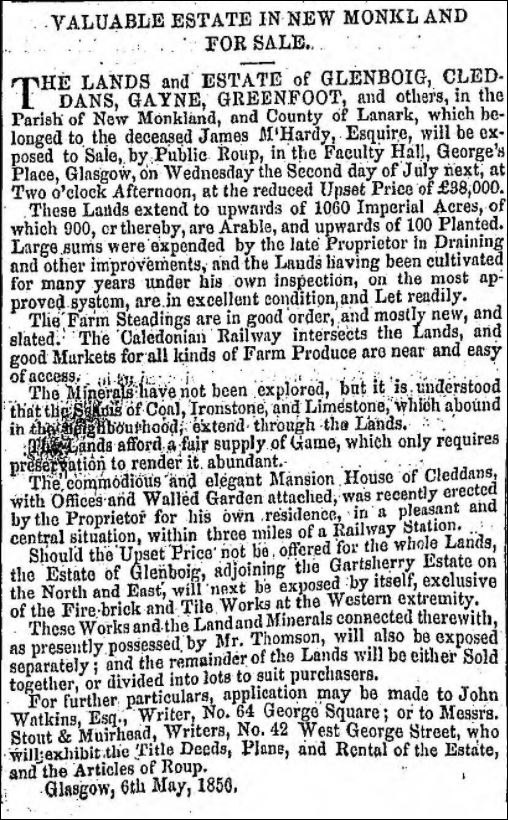
c. 1858 – James Dunnachie joins the company as a bookkeeper and traveller.
1858 – Mineral Statistics of the United Kingdom of Great Britain and Ireland for 1858 – Glenboig, clay of coal measures. Name of freeholder – Patrick Rankine Esq. Manufacturer – John Thompson. Manufacture – Bricks, covers, flooring tiles and blocks. Estimated 3,880 tons annually.
Below – 1858 – Glenboig Firebrick Works.
Below – 1858 – Glenboig Firebrick Works.

1858 – 1861 – ScotlandsPlaces – Glenboig Fire Brick Works. John Thomson Esqr. Tolerably sized Fire Brick Works situated at the northwestern extremity of the Parish. The property of John Thomson Esqr.
1860 – John Thompson is joined by Richard Smith and Charles Mclean under the partnership name of Thompson McLean and Co.
Below – 14/12/1860 – Glasgow Herald – Advert for sale of lands at Inchnouch, adjoining the Estate of Glenboig. The lands are understood to contain fire clay and plastic clay, cement and sand, some of which have been wrought to advantage in the adjoining lands …
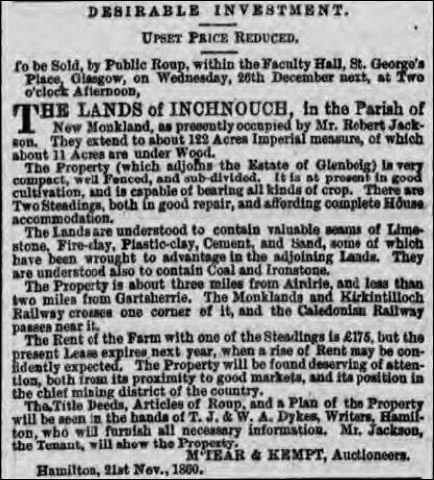
02/08/1861 – Glasgow Herald – Reference to Mr James Thomson (not John ?), Glenboig Fireclay Works being available to show potential tenants around the adjoining Inchnouch Farm, New Monkland.
1861 – 1862 – Thomson, McLean, & Co., fireclay manufacturers, Glenboig, by Coatbridge, 49 West George Street.
1865 – Richard Smith of Thompson McLean and Co. dies and the company dissolves.
1865 – James Dunnachie takes over the company and forms the Glenboig Fire-clay Co with John Hurll and John Young, themselves pioneer firebrick manufacturers. They pay £5,000 for the works.
Below – 06/01/1866 – Glasgow Herald – Thomson, McLean & Co, Fire brick manufacturers, Glenboig of which Charles McLean and the Late Robert Smith were partners has been dissolved on the death of Smith (28/10/1865). Mr Smiths’ trustees will carry on the brick business. Mr McLean has left the brick business to continue other interests.
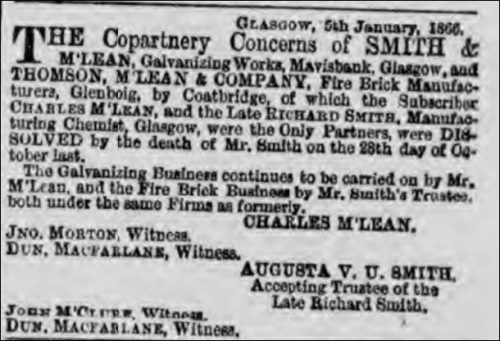
20/01/1866 – Perrys Bankrupt Gazette – Scotch partnership dissolved – Charles McLean and Augusta V. A Smith, deceased, fire brick manufacturers, Glenboig, near Coatbridge and Glasgow, 23rd Oct.
25/05/1871 – Greenock Telegraph – Mad freak – Early on Tuesday morning a fearful explosion of gunpowder, resulting from the freak of a collier, occurred at Inchneuk Cottages, Glenboig Brickworks, by Coatbridge. A miner named Stewart McCandlish occupied one of the cottages, in which there resided, besides himself and wife, two lodgers named William Beckett and Francis McMahon. On Monday McCandlish and the two lodgers had been indulging in a carouse, which was prolonged till about one o’clock Tuesday morning, the three men sitting the fire with bottles and glasses drinking and joking. The fire, having become low, McCandlish took a cask of powder which kept for use in blasting, and taking it below his arm, commenced throwing handfuls of powder from the cask into the fire. Ere long the powder ignited, and a fearful explosion ensued. The house was broken to pieces, the door being broken into splinters, and the three men much injured. The two lodgers, Beckett and McMahon, who had remained sitting at the fire while McCandlish threw in the powder, were severely cut and burned about their heads and arms; while McCandlish was blown completely out of the house some distance. When picked up, it was found that he was also dangerously hurt; but providentially Mrs McCandlish, who was in bed at the time, escaped without the slightest injury. James Donnachie, Esq, of the Glenboig Works, who was at once sent for, bestowed every attention on the injured men and sent for Dr Murray of Muirhead. On the doctor’s arrival, he ordered the removal of the three men to the Glasgow Royal Infirmary, and a conveyance being kindly granted for that purpose by Mr Donnachie, Beckett and McMahon were removed without delay. McCandlish, however, would not allow himself to be taken. The whole of the men remain in a very precarious condition, little hope is entertained of their recovery.
1872 – When the Dunnachie, Hurll and Young partnership folded in 1872, Dunnachie built the Star Works immediately adjacent to the Old Works, and in competition with them. His bricks, at that time, bore the legend J. D. and the title “Star Works, Glenboig” or “Glenboig” with a star imprinted below the word. Hurll and Young went off and started the Cardowan Fireclay Company together and took over the Heathfield Brickworks which had started c. 1833.
1872 – 1873 – James Dunnachie (of the Glenboig Fire Clay Co.) Glenboig Cottage, near Coatbridge.
Below – 26/12/1873 – Edinburgh Gazette – Glenboig Fire Clay Co taken over by John Hurll.
03/05/1878 – Aberdeen Press and Journal – Paris Exhibition. Exhibitors – James Dunnachie, fire clay manufacturer, Glenboig Star Firebrick Works – fire bricks as used in the Seimens’ furnace, forge, rolling mill, puddling and all other descriptions of furnaces subjected to the most intense heats and sudden changes in temperature; glasshouse blocks; fire clay tuyeres used in the Bessemer steel process; and samples of Glenboig star fire clay; Hislop’s built gas retort …
05/04/1878 – The Scotsman – Paris Exhibition – The following Scottish Companies will contribute – … The Glenboig Fireclay Company, Coatbridge send samples of brick specially adapted for resisting the most intense heat. These bricks are largely used in the iron, steel and chemical works of Newcastle, Cleveland and West Cumberland districts while more than a million are forwarded yearly to Germany, Russia and Belgium. The fireclay used in them is, in point of geological position, the lowest known in the Lanarkshire carboniferous formation being at Palace Craig 700 yards below the surface, though owing to some upheaval it is worked at Glenboig at a depth of 40 yards …
10/09/1878 – Glasgow Herald – Paris Exhibition – In class 66 (Architectural and building materials) the Glenboig Fire Clay Company, 68 Bath Street, Glasgow are to receive a silver medal. Mr James Dunnachie, Glenboig Star Fire Brick Works, 2 West Regent Street is awarded 2 silver medals – 1 in class 66 and the other in class 43(metals and refractory materials) including tuyeres, runners, plugs, stoppers, etc for use in Bessemer & Siemens Steel processes.
17/10/1879 – The Argus, Melbourne – Alex Sutherland and Co are selling Glenboig Star firebricks.
26/02/1880 – The Sydney Morning Herald, NSW – Scott Henderson & Co agents for Glenboig Star firebricks.
25/05/1880 – Greenock Advertiser – Honours to Scottish exhibitors – James Dunnachie, Star Fire Clay Works – Refractory fire bricks, gas retorts, etc.
23/04/1881 – Lanarkshire Upper Ward Examiner – Explosion in a clay pit. On Thursday forenoon a miner named Robert Armstrongresiding at Glenboig got himself rather severely Robert Armstrong burned by an explosion of gunpowder which occurred when he was at work in a clay pit at the Star Fire Clay Works, Glenboig belonging to James Dunnachie. Armstrong had been in the act of tilling a charge of gunpowder for the purpose of firing a shot when a spark fell from the lamp which he had in his cap, amongst some loose gunpowder he had in his hand. An explosion ensued and he was burned pretty severely about the face. Dr Murray, Muirhead attended upon the sufferer and is of the opinion that no fatal issue is at present impending.
28/05/1881 – Invoice – Glenboig Fire Clay Company, Glenboig Fire Brick Works near Coatbridge. Depot, Head of Glebe Street, St Rollox, Glasgow. Office, 68 Bath Street, Glasgow. Fire bricks, sewerage pipes, chimney cans, silver sand.
28/05/1881 – Dundee Courier – Prosecution under the factory Act. Employer fined £70. On Thursday before Sheriff Mair at the Airdrie Sheriff Court, John Hurll, proprietor of the Glenboig Fire Clay Works was brought up at the instance of Mr Strokes, H.M. Inspector of Factories on a charge of having neglected to fence the shaft of a pipe mill in the fire clay works at Glenboig, whereby a young woman named Jane Davison, was caught by the dress by a revolving shaft and so seriously injured that she shortly thereafter died. Mr Hurll pleaded guilty and the Sheriff sentenced him to pay £70 with £1 3s of expenses and failing payment, 2 months imprisonment. The Sheriff in giving his decision requested the Government inspector to communicate with the Secretary of State as to the payment of the fine to the parents of the deceased as provided for in the Act.
August 1881 – Invoice – Invoice – Glenboig Fire Clay Company, Glenboig Fire Brick Works near Coatbridge. Office, 68 Bath Street, Glasgow. (The office is also recorded on this invoice as being 188 Buchannan Street, Glasgow but this has been scored through). Fire bricks, sewerage pipes, chimney cans, silver sand.
13/10/1881 – Glasgow Herald – Important improvements in burning fire bricks. A new application of heat regeneration. During the last twenty years or so, and more especially since the Bessemer and Siemens processes of making steel came to be established as great manufacturing industries at home and abroad, the district of Glenboig, near Coatbridge, has acquired a great reputation for the character of the bricks and other goods from the millstone grit fire-clay which has been so beautifully deposited in that particular portion of the Lanarkshire coalfield. For furnace construction, there is nothing to surpass a genuine Glenboig brick in respect of its fire-resisting power unless it is that peculiar product of South Wales manufacture known as the Dinas fire-brick, which, however, is almost exclusively composed of silica and has but a limited range, of practical application. When some important improvements in burning fire-bricks are completed it may confidently be expected that Glenboig manufactures will rise still higher in reputation. Occasionally in recent years some of the manufacturers of fire-bricks of this country have considered it desirable to adopt the heat regenerative system to the burning of such goods, but in no attempt that has been made, so far as we are aware, has any marked economical result been attained until within the last two or three weeks. The special case to which we are about to refer is that of Mr James Dunnachie, of the Glenboig Star Fire-Brick Works, where there are manufactured goods of such remarkably refractory power as to be in, great demand for furnace construction. Having a raw material of such splendid quality as a fire-resisting medium, it was but natural that the gentleman whom we have named should exert every endeavour to turn it to the best possible account, both in the preparing and moulding stages of the manufacture and in the economical and perfect firing of the bricks after being prepared. Having lately inspected the new firing arrangements at the Star Fire-Brick Works, we give a brief sketch of the modus operandi pursued by Mr Duunachie and we would just remark in passing that the arrangements in question, which have long been worked out, were first brought into practical use in connection with the adoption of the Wilson, producer to supply the requisite gaseous fuel. It is not necessary that we should here describe that useful and valuable invention, but it is proper to state that this is the first occasion for it to be employed in the successful burning of fire-bricks. As at present developed, the arrangement adopted is a kiln consisting of two parallel stacks of brick work, about 24 feet apart, and each containing five separate chambers, in each, of which from 13,000 to 14,000 bricks can be fired at one “heat.” In order that the kiln may be capable of continuous regenerative firing the two sets of chambers are connected with each other at the two ends by means of under-ground flues, and in this way the ten chambers may be regarded as one continuous series – that number being required for completely carrying out the ideas of the inventor, The space between the two parallel stacks of brickwork is covered in by means of an iron roof, so that the operations of charging the green bricks and discharging the finished goods may be pursued in all kinds of weather. ‘There are, however, doors at both ends of the chambers. At the west end of the space just referred to there are erected two of Wilson’s gas producers of large proportions, for which the gaseous fuel is led to the underground flues for working the separate chambers when charged with bricks to be fired. One great advantage of this system of heat-regeneration in burning fire-brick is that there is always a regenerator chamber in readiness for heating the air requisite for the combustion of the gaseous fuel. Of course, in commencing the process at the Star Fire-brick Works it was necessary to fire the first chamber in the usual way by means of specially erected coal furnaces, but as soon as it was fired off, it was ready to become part of the future plan as the first regenerator chamber. At the time of our visit, the system was in successful operation with one set of five chambers, and the stack of brickwork containing the other five was in rapid progress. ‘The experience with the gas-fired kilns up to the present is that the firing operation can be thoroughly performed in from 18 to 24 hours, whereas in the best type of kilns used at the same works, employing coal as the fuel, the burniug usually occupies from four to six 12-hour shifts. It is not considered a too sanguine expectation to suppose that, if desired, the time required for burning off a kiln chamber under the new order of things may eventually be reduced even to 12 hours. There is no necessity, at this early stage of Mr Dunnachie’s operations, for giving any detailed account of the structure of his new kiln, and we, therefore, limit our remarks to a brief notice of the mode of employing the gas and air – the fuel and the supporter of combustion. Assuming, then, that No. 1 chamber has been fired off, and that the effluent gases produced in the combustive process have passed through chamber No. 2, which is the next in the series, the contents of the latter are now in all probability at a bright red heat; the gas from the producers – at a temperature of from 600 degs to 800 degs Fahrenheit – is turned on direct to No. 2. and so likewise is the highly-heated air that is streaming through No. 1 – the regenerator chamber. These two currents are allowed to mix in the fires or burners beneath the floor of the chamber, and a magnificent glowing effect is soon evident. The underground flues are provided with valves that can be brought into action at a moment’s notice for turning on or turning off the gaseous current and regulating it according to the condition of the mass of bricks being operated on at the time. These valves are worked in the covered space formerly referred to and at what may be termed the working front of the kiln. The quantity of air that passes from the regenerator chamber is regulated by means of dampers, which are also under the most complete control. At the end of from 18 to 24 hours, the firing is completed, and the particular chamber that has just been burned off becomes, in its turn, the regenerator for the next in the series, which by this time has doubtless already attained to a full red heat through the action of the heat of the effluent gases, but which heat is economised in the manner indicated. And in this way, the new system of using gaseous fuel in the fire-brick manufacture may be fitly spoken of as one of continuous heat regeneration. The economy already attained as regards fuel is very significant, the saving of which is upwards of 50 per cent, and there is every reason to expect that it will yet reach 75 per cent when the other five-chambers are brought into use. Besides the economy in fuel just stated, and the speed in burning, the special features of the new system of firing that have been aimed at and attained are the use of gaseous fuel, combined with the perfect diffusion of the heating current. Owing to the manner in which the gas and air flues are arranged in each chamber the most absolute perfection is attained in the admixture of the gas and hot air for the burning process before they are admitted into the kiln chamber proper. It is also worthy of mention that, if the front of the kiln should become too hot, cold air can be admitted at pleasure, and that it is possible to take off the effluent gases from any one chamber either at the top or bottom. Furthermore, the heat current may be conveyed directly to the next chamber in the series, so that there is practically no waste of heat at any stage of the process. From all the various circumstances which we have mentioned, we may (using the remark of a competing manufacturer of fire-bricks) characterise Mr Dunnachie’s new system of burning bricks as being a revolution in the manufacture. So for as can be seen at present, there is abundant reason to believe that the same system of using gaseous fuel in continuous regenerative firing may be adopted with an equally marked economy in the manufacture of pottery ware and in other more or less similar industrial processes.
04/11/1881 – Dundee Courier – A letter was read from the Glenboig Fire Clay Company stating that they were working up to stoop the fireclay below the school at Glenboig and the matter was remitted to the clerk to examine the plans and report at the next meeting.
1882 – The Starworks and the Old Glenboig Works companies decided to amalgamate as the Glenboig Union Fireclay Company Ltd with Dunnachie as Managing Director.
1882 – The Cumbernauld Fire-clay Co (founded 1874) or Cumbernauld Fireclay Works and Mine, had works beside the Caledonian Railway with fire-clay from Abronhill. In 1882 the Works are sold for £4000 to the newly formed Glenboig Union Fire-Clay Co, under James Dunnachie. The company was registered on 26 August, to acquire the businesses known as the Glenboig Fire Clay Works and the Glenboig Star Fire Clay Works, carried on by James Dunnachie and the Glenboig Fire Clay Co respectively at Glenboig, near Coatbridge, Lanarkshire.
Below – 23/12/1882 – First General meeting of the members of the Glenboig Union Fireclay Company – John Hurll presiding.
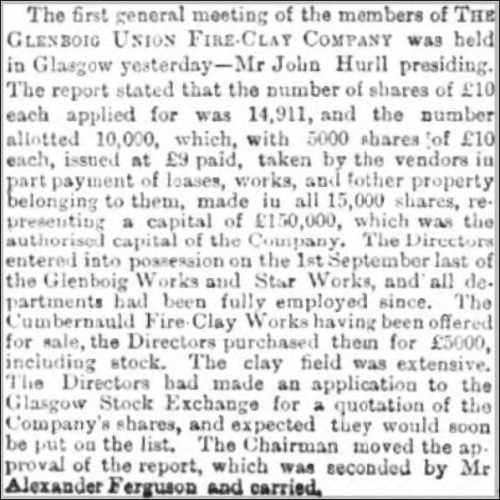
06/06/1882 – Invoice – James Dunnachie, Star Fire Brick Works, Glenboig near Coatbridge. Office, Victoria Buildings, 2 West Regent Street, Glasgow.
Dunnachie’s invention of a gas kiln for firing bricks was to earn him even greater praise and money. The gas kilns first proved themselves at the Company’s works at Glenboig, Cumbernauld and Gartcosh, as they allowed greatly increased temperatures and considerable savings in fuel costs.
Palacerigg Mine 1884-1958 called the “Glen Cryan Mine” was first run by Glenboig Union Fireclay Co. Amalgamated with General Refractories of Sheffield (but continued to trade in Scotland under the Glenboig name).
1883 – 1897 – Invoices – Numerous. All headed The Glenboig Union Fireclay Co Limited, Victoria Buildings, 4 West Regent Street, Glasgow.
Below – 03/02/1883 – Glenboig Evening Post –

05/02/1883 – Glasgow Herald – James Dunnachie and others V John Young & Sons. The complainers here are the proprietors of the Star Fire-Brick Works, Glenboig, near Coatbridge, and the Glenboig Fire-Clay Company, Glenboig, and they sought to interdict the respondents, who are sewage-pipes and fire-clay goods manufacturers, Heathfield and Cardowan, Lanarkshire, from selling, shipping, or exporting any fire-clay goods stamped with the word Glenboig other than fire-clay goods manufactured by the complainers. They state that the clay obtained in the Glenboig seam, which is co-extensive with the farm of Glenboig, is of superior quality, that it is especially valuable in the market, that it belongs to and is marked by them; and that the respondents have been making and selling goods under the name of Glenboig with the view of deceiving purchasers. Last year the Lord Ordinary on the bills granted interim interdict and ordered answers. In these the respondents say that they own and work the clay of the Glenboig seam; that the clay is identical in quality through the whole extent of the seam, extending beyond Glenboig Farm; that the goods made a from it are known as Glenboig goods by whom-so- ever made, and that the term is not confined to goods made by the complainers. In addition, they maintain that the trade and the public have long known that they made goods from the Glenboig seam and sold such goods as Glenboig and further, that it was a recognised custom that all goods manufactured from a particular seam should be so described, no matter who made them. Evidence was led at considerable length a fortnight ago, and today decision was given in favour of the respondents. The Lord Ordinary said that there were two things which the interdict was intended to strike at – first, the imitation of the trademark of both or either of the complainers; and, second, the use of the name “Glenboig” at all, not merely as a trademark in the proper sense, that was, as a distinctive mark impressed upon the respondents’ goods, or affixed as a distinctive word in catalogues, advertisements, or in any other way to designate goods manufactured and sold by them, and that irrespective altogether of the meaning that they may take to inform their customers or the public that they are not goods manufactured by either of the complainers. The second of these claims was pressed by the Solicitor-General, who stated that certain circulars and advertisements which the respondents had been in the habit of issuing for many years without complaint could not have been effectively challenged although they fell within the terms of the interdict now asked. His Lordship did not now understand it to be maintained that the complainers had acquired such an absolute and exclusive right in the use of the word Glenboig that they were entitled to prevent another manufacturer employing it as a distinctive of fire-clay goods which were not themselves marked with it, even though he did so in a way neither calculated nor intended to deceive. Nor was it intelligible that such an exclusive right to the use of a distinctive name should be vested at the same time in two independent and competing manufacturers. The question requiring consideration, therefore, appeared to his Lordship to be whether the complainers were entitled to interdicts in the terms asked against the use of the word “Glenboig” by the respondents a trademark, or against his use of that word in combination with another word or words because it was perfectly clear that the use of the word “Glenboig” by itself would be a direct invasion of the Glenboig Company’s right. The two complainers are tenants of portions of a bed of clay lying under the lands of Glenboig, and each of them has works situated upon the lands. Their averment and it was entirely borne out by the evidence, was that the clay on the Glenboig Farm possessed many exceptional qualities, and was described as possessing to a larger extent than other fire-clays the power of resisting heat at high temperatures, and in particular that the goods made from it are free from the risk of cracking after being subjected to an extreme heat. This was a most valuable quality in fire-clay goods. And then the complainers went on to say that the goods manufactured by them had acquired a favourable reputation in districts where they were used, as Glenboig goods. Each of the complainers is the registered proprietor of a trademark which they impress upon the goods manufactured by them. The Glenboigs Company’s mark consisted of the word ‘Glenboig’ alone, while Messrs Dunnachie’s mark is a device consisting of the words ‘Star Works, Glenboig’ with a star and the initials ‘J D’ between these two letters. The complainers said, and they quite clearly proved, that these two words, ‘Glenboig’ and ‘Glenboig’ Star’ had established a reputation for excellence, and commanded a high price both, in the home and foreign markets. There could be no doubt that the complainers’ goods were in great demand and had a fair reputation both in this country and on the continent, and that reputation, which was proved to be well merited, was of great commercial value. There could be as little doubt that this high reputation was attributable not to any peculiarity or special excellence in the manufacture, but to the distinct qualities of the Glenboig clay. It was not disputed that the complainers are excellent manufacturers and that they would not have acquired a reputation for their fire-clay goods had they not been well and carefully made, but at the same time there was nothing exceptional in their process, and if the same material had been wrought by another competent manufacturer his goods must have obtained the same currency and demand as those of the complainers. Without going into details, his Lordship was of opinion that the respondents, who are the lessees of a fire-clay field in the immediate neighbourhood of the complainers, began about eight years ago to work a seam identically good in quality to the seams worked by the complainer. It was, in his opinion, perfectly immaterial to consider whether there was uninterrupted continuity of a strata between the mineral field worked by complainers and the mineral field worked by the respondents. For all practical purposes, they were working the same seam, and his Lordship thought it had been proved that before the respondents reached that seam it was known among engineers and fire-clay manufacturers to extend beyond the limits of the area leased by the complainers and that both within and beyond that area it was known by the name of Glenboig clay, and by no other name. Now it appeared to his Lordship that as soon as the respondents had reached Glenboig clay and had begun to work it they were in entitled to take advantage, not of the complainer’s reputation as manufacturers, but of the reputation of the valuable raw material which they had ra acquired and accordingly it was hardly disputed in the argument that they were justified in issuing circulars in 1874 stating that they were engaged sinking a pit to the fire-clay known as the Glenboig seam. From that time downwards they had constantly advertised in various forms that they were manufacturing bricks from the clay known as Glenboig. That had been done without challenge from any of the complainers. Assuming these proceedings to be within the respondent’s rights, it was of course clear that they were not entitled to imitate the trademark of the complainers or in any other way to represent that the goods they sold were goods manufactured by the complainers. The complaint was that the respondents proposed to brand their bricks with the words ‘Young’s Glenboig’ and this was said to be a mere colourable imitation of the trademarks of the complainers. But neither of the complainers, in His Lordship’s opinion, was in a position to maintain that the use of the word “Glenboig,’ although accompanied by a distinct variation, was in itself an infringement of his trademark, because each of them as against the other had a right to the use of that word. They were competing against each other in the home and foreign markets, which conceded a right which in this action they both denied to the respondents. The only question, therefore, appeared to be whether the variation which had been adopted by the respondents was sufficiently distinctive. In his Lordship’s opinion the brand ‘Young’s Glenboig’ was just as distinguishable from Mr Hurll’s ‘Glenboig’ and Mr Dunnachies ‘Star Glenboig’ as either of these was from the other. There had been a great deal of evidence on this point, but it had been entirely in accordance with the conclusion that His Lordship had arrived at, that the brand ‘Young’s Glenboig’ could deceive nobody. But it had been said that in Russia and Germany it would be different. If it were so it might be a question how far that which was otherwise an ordinary bona fide trademark, used by a trader in this country, and unimpeachable here, could be prohibited and interdicted, merely because it was liable to lead to misapprehension in particular markets. There was no authority, so far as he knew, for that proposition. The marks being, names or words in the English language, they would be quite distinguishable wherever the words could be read and understood. On the whole, his Lordship was of opinion that the interim interdict formerly granted must be recalled, and the note of suspension refused, with expenses to the respondents …
23/05/1883 – Glasgow Herald – James Dunnachie and others V John Young & Sons – The complainers and reclaimers here are the proprietors of the Star Fire Brick Works, Glenboig, near Coatbridge and the Glenboig Fire Clay Company, Glenboig, and they sought to interdict the respondents, who are sewage pipes and fire-clay goods manufacturers, Heathfield and Cardowan, Lanarkshire from selling, shipping, or exporting any fire-clay goods stamped with the word Glenboig other than fire-clay goods manufactured by the complainers. There was a further conclusion in the prayer of the petition against the respondents advertising, for sale any goods as Glenboig goods other than those manufactured by the complainers, and also to prevent them, using the words objected to on invoices, memorandums, &c. The Lord Ordinary Kinnear after hearing evidence in the case issued an interlocutor finding in favour of the respondents, with expenses. A reclaiming note was presented against this decision, and upon it, counsel were heard towards the end of the last session, and avizandum was then made. Today the Court decided the case.
The Lord Justice Clerk, who gave the leading opinion, said that two questions were raised in this case – first, whether the respondents had assumed and applied to articles manufactured by themselves the trade name in use to be applied by the complainers to articles manufactured by them, and that for the purpose of inducing purchasers to believe that such articles were manufactured by the complainers; and secondly and separately, whether the respondents had used arid applied to their own ware the registered trademark of the complainers. The relative position of the parties to this dispute, His Lordship said, might be very shortly described. Both were manufacturers of goods from fire-clay, their works being situated about two miles from each other, and they used in their manufacture the clay found in the lands on which these works were placed. The name of the lands on which the complainer’s works stood was Glenboig and that of those occupied by the respondents Heathfield. The same seam and quality of clay were found in each. It had been the invariable practice in this trade to name the ware manufactured at the different works by that of the lands which they occupied, and thus the manufacture of the complainants had been universally known in the trade as Glenboig, and that of the respondents as Heathfield and they passed under these denominations in the market, and the ware, had been stamped with these respective names. It appeared, however, that the Glenboig fire-clay had attained a reputation in the market which Heathfield had never reached, and hence this controversy. The superiority of Glenboig was attributed by Heathfield to the fact that the former used in the manufacture a seam of clay of fine quality, which, although existing on the Heathfield lands also, the respondents had not been fortunate enough or skilful enough to arrive at. At last, in 1874, their workings struck this seam; and not allowing the excellence of their ware to make it known to the trade, they had pursued a system of advertisement in order to publish the fact that they were working the same seam of clay as that found at Glenboig, until at last, in 1882 they began to stamp the Heathfield ware with the words ‘Young’s Glenboig’. The object of these proceedings was not disguised. The Heathfield ware had no connection whatever with the neighbouring works, any more than it had with the other fire-clay fields in the vicinity, where precisely the same seams of clay occur; and it would have been quite reasonable to have called these fire bricks by the name of Garnkirk, Gartcosh, or Cumbernauld, as to stamp them with the name of Glenboig. The object of the proceeding was to attract to Heathfield goods part of the popularity of Glenboig. But it was said that in stamping their ware with the word ‘Glenoboig’ the respondents did not mean the trade or the public to understand that these goods were made at Glenboig, but only that they were made out of a seam of clay which they alleged to be known as the Glenboig seam. If it were material to the question before the Court his Lordship thought the evidence brought to establish that the word ‘Glenboig’ was known as a generic name applicable to a particular seam of clay wherever found, was both untrustworthy and inconclusive. The perusal of it had satisfied His Lordship that until the respondents commenced their advertisements in 1874 there was nothing like a general or even a partial use of the name in this sense even among scientific men. But it was quite sufficient for the present purpose that the witnesses were all agreed that until 1882 the invariable practice in the trade was to name the fire-bricks after the name of the lands on which they were manufactured and that none were even known to be named after a particular seam of fireclay. It followed from this universal custom that the name of Glenboig meant in the trade when applied to fire-bricks, those manufactured at the Glenboig Works, and was not understood or intended to mean anything else. His Lordship came to the conclusion, and with no hesitation that in stamping their goods with the words ‘Young’s Glenboig’ the respondents intended their customers to believe that they were manufactured at Glenboig and that because of the high reputation which that manufacture had attained in the trade. They could not mean their customers to believe that the word ‘Glenboig’ merely described the seam, because they knew that this was never done in the trade. On this part of the case, His Lordship said, he should desire no further evidence than that afforded by the immediate facts out of which this dispute had arisen. In 1882 the complainers received an order from a Glasgow firm for a large quantity of fire-brick. The complainers were too busy to undertake it, and they recommended the respondents to their customers. In the execution of this order, the respondents for the first time used the stamp ‘Youngs Glenboig’. The complainers immediately remonstrated, and Mr Young at once expressed his deep regret and said it had been done without his knowledge and that it was very wrong and should not happen again, and entreated the complainers to intercede with the Glasgow firm to accept the goods without the word ‘Glenboig’ stamped on them. But the Glasgow firm were obdurate. They wanted the stamp of Glenboig because their customers would accept no other, proving clearly that the trade attached no consequence whatever to the seam of clay from which they were manufactured and cared only for the stamp of the Glenboig manufactury. If this were so the addition of the word ” Youngs” was merely colourable. His Lordship was therefore entirely with the complainers on the first point and the second became immaterial. He was, however, of the opinion that the respondents had infringed or adopted the registered trademark of the complainers. But it had been contended that the respondents had not adopted the trademark, because ‘ “Young’s Glenboig'” was not the trademark. This contention appeared to His Lordship to be quite inadmissible. The respondents were not entitled to use the trademark and had no reasonable excuse for doing so and the addition of their own name would not justify them in adopting the trademark of their neighbour. It was said that Mr Dunnachie, who was also a manufacturer on the lands of Glenboig, had used without objection from the other respondents the trade name of ‘Star Glenboig’ and that, therefore, anyone who chose might adopt the trademark of the company if any other word were put before it. His Lordship could not see anything in this view, or any analogy between the cases. The ‘Star Glenboig’ ware was rightly and honestly so-called, unlike that of the respondents. It was Glenboig ware. The name expressed nothing but the truth, Whether the assumption of that designation would or would not have been an infringement of the other company’s trademark the court needed not to consider because it was not challenged. It did not follow that the trademark would have been acquired at all but for the acquiescence of the company in the modification thus introduced. His Lordship was, therefore, prepared to grant interdict prayed for in the first part of the prayer. In regard to the advertisements, although they were ambiguous and perhaps disingenuous, he was not prepared to say that they all constituted a violation of the complainer’s right. The respondents were entitled to say that their seam of clay was the same as that found in Glenboig, for that appeared to be true, but they were bound to make their meaning quite distinct and to use no word which could lead to the inference that the goods referred to were made at Glenboig. But the prayer of the petition was much too wide and he thought the complainers would be well advised if they confined their demands to interdict against stamping the goods and depart from the rest of the prayer. The other judges concurred in this opinion.
Mr Trayner for the complainers said that they accepted the suggestion of the bench and they did this all the more readily that they honestly believed that Messrs Young would be as glad to yield real obedience to the court as the complainers were to accept the suggestion.
A short discussion then took place on the question of expenses and the court on the grounds that the complainers had been substantially successful, gave them expenses …
17/09/1883 – The Scotsman – The following is the list of awards to Scottish exhibitors at the International, Colonial and Export Exhibition, Amsterdam 1883. Gold medal – Glenboig Union Fireclay Company Limited, Glasgow.
11/09/1883 – Ayrshire Post – Patents for inventions. List of specifications published during the week ending 1st September 1883, prepared by Geo. M. Cruikshank, patent agent, 133 Buchanan Street, Glasgow … Dunnachie silica bricks …
25/10/1883 – Glasgow Herald – The annual general meeting of the Glenboig Union Fireclay Company Limited was held yesterday in the company offices, West Regent Street. Mr John Hurll presided and there was a large attendance of shareholders … their customers were spread over Europe and America and they had shipped large quantities of goods during the past year, more indeed than had been sent for many years. The French, German and Russian trade had been fair. They had had some trouble in regard to an infringement of their trademarks but the company had been successful and they were not likely to be interfered with in future … dividend 9% …
Below – 1884 – Property Index 1884

14/06/1884 – Lanarkshire Upper Ward Examiner – Glenboig was the scene of considerable rejoicing on Tuesday last. Banners were flying all day in various parts of the works, guns were fired at intervals during the afternoon and evening, and, as soon as darkness began to set in, great fires were raised, leading the passengers by the trains to ask the question, ” What’s a’ the steer ?’ It was the marriage of Dr John Murray of Chryston to Miss Mary Jane Gibbes. The celebration took place at Glenboig in the house of Peter Hurll, Esq, brother-in-law to the bride, the officiating clergyman being the Rev. John Moodie of Kippin, formerly of Chryston. On the afternoon of Saturday last, at a meeting held in the schoolroom, Mr Thomas Dunnachie, in name of the employees of the Glenboig Union Company (Ltd.), presented the doctor with a valuable marble timepiece, and Miss Gibbes with a pair of bronze statues and a set of beautiful fruit knives, as a token of esteem, on the occasion of their marriage
Below – 17/01/1885 – Clyde Bill of Entry and Shipping List – Glenboig Union Fire Clay Company Limited.

26/01/1885 – The Scotsman – Glenboig Union Fire Clay Company Limited V John Young & Son. Another court case brought about by the Heathfield works using the Glenboig trademark. Heathfield appears not to have adhered to the Court’s decision in 1883 that they were wrong to use the Glenboig name.

14/03/1885 – Edinburgh Evening News – In the Court of Session today, it was intimated to LordJFraser that the action at the instance of the Glenboig Union Fireclay Company, West Regent Street, Glasgow, against John Young & Sons, Bath Street, Glasgow, in which interdict was asked of defenders advertising themselves as manufacturers of “Glenboig,” “Glenboig Fire,” ” Glenboig (Young’s),” “Young’s (Glenboig),” fire-clay goods, and, in addition, damages to the amount of £5000 were asked, had been settled. Defenders said that for 25 years they carried on business at Glenboig, and prior to 1873 Mr John Young, of their firm, was in partnership with the gentlemen who now direct the pursuers’ company. The term “Glenboig” was maintained, was not confined to pursuers’ goods, but was distinctive of goods manufactured from Glenboig clay. Counsel intimated that interdict was to be given, £5 paid damages, and it was proposed that neither party be found entitled to expenses. Exception was taken on behalf of the pursuers to the length of the minute agreement and his lordship today merely allowed it to be received and seen, reserving discussion upon that point.
26/08/1885 – Dundee Courier – The Antwerp Exhibition – Scotch awards – Gold medal, Glenboig Union Fireclay Co Ltd. They also received a bronze.
Below – 1886 – Glenboig Union Fireclay Co Advert – (Note SBH – “contractors to her majesty’s home and Indian Governments ” – At this time or thereafter I theorise that Glenboig started to add a ‘crown’ design to their bricks).

Below – 01/05/1886 – Rutherglen Reformer – James Guthrie was killed while working in the fire clay pit at the Star Brickworks, Glenboig. James Dunnachie assists with medical treatment.
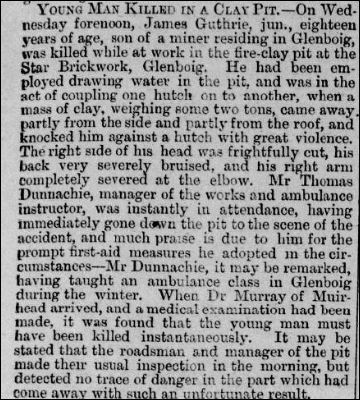
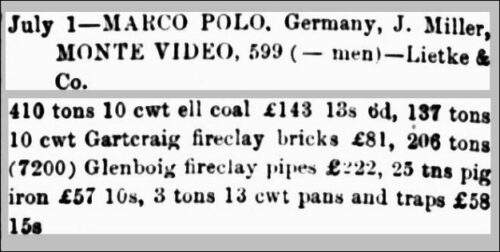
24/07/1886 – London Daily News – Prospectus for Thomas Carr and Son, Fireclay manufacturers … The new gas process is already in operation in some of the largest Fireclay and Brick and Tile Works in the Kingdom, amongst which are the following: Glenboig Star and Cumbernauld Fire Clay Works of the Glenboig Union Fireclay Company and the Garnkirk Fireclay Works …
04/10/1886 – Annual General Meeting of the Glenboig Union Fireclay Co records John Gilchrist Stein as a shareholder.
Below – 05/02/1887 – Clyde Bill of Entry and Shipping List – Glenboig Union Fire-Clay Co Ltd.

24/12/1887 – South Australian Register, Adelaide. J Stilling & Co, Cavendish Chambers, Grenfell Street, Adelaide are sole agents in South Australia for Glenboig Fireclay Company’s firebricks
1888 – In 1888 the architect Clarence Backhouse clad a whole of the front facade in Glenboig bricks at the NSW Electric Light and Power Supply building in Kent Street, Sydney, Australia. These were not necessarily the ‘Starworks’ bricks from Glenboig referred to above, but possibly the products of the Glenboig Union Fire Clay Co, which were currently on show at the Centennial International Exhibition.
24/04/1888 – Hamilton Advertiser – Glasgow Exhibition. The Glenboig Union Fire Company (Limited) show a most complete exhibit of fire clay articles used for metal smelting at home and abroad. It includes the fire bricks blocks required in the manufacture of steel, iron, copper, brass, lead, glass and the special bricks for the Siemens, Gormon, Ponsard, Klonne, Coppee, Cowper, Whitwell, Ford & Moncur and Bauer furnaces and ovens, gas retorts and all kinds of settings, glazed sanitary pipes, traps, syphons &c, ganister & silica furnace bricks, Glenboig ironstone paving tiles for railway stations and other public places, fireclay ground and unground, silver sand &c. The Glenboig Company have received 22 prize medals at the various International Exhibitions and have never failed to secure the highest award given for their class of goods.
20/06/1888 – Colonies and India – The Barcelona Exhibition – The Glenboig Union Fire Company (Limited), Glasgow. This company is represented by a large collection of their Glenboig bricks and fireclay goods. The superiority of the Glenboig fireclay over that from other mines has long been established as it is remarkably free from any bases such as oxide of iron, lime &c, that have a tendency to make the clay softer with heat. The potash contained in it is also much lower than usually found. These qualities render the Glenboig bricks&c peculiarly serviceable for an almost innumerable variety of purposes and especially so for stoves, blast furnaces, kilns &c. The company have built gas retorts for a number of gas companies in the United Kingdom and have had nothing but pleasing and satisfactory reports in connection with any of them. The clay also lends itself to many uses of a decorative nature and many pleasing designs have been fashioned for such purposes as flower stands, garden tables, seats &c while for chimney pots, grate backs or flooring tiles it is used in endless varieties.
Below – 09/09/1888 – Glasgow Herald – Formation of a co-operative society in Glenboig. Mr Hurll addressed the meeting.

12/12/1888 – Glasgow Herald – Melbourne exhibition – … The Glenboig Star Fire Brick Works near Coatbridge, Scotland has an extensive variety of fine brick articles, samples merely of different things from a fire brick and numberless patterns in varied forms up to pipes and drains of many sorts and sizes …
Below – 1889 – Glenboig Union Fireclay Co Advert.

02/03/1889 – Glasgow Herald – A few labourers wanted. Wages 16s per week. Apply Star Works, Glenboig.
12/10/1889 – Lanarkshire Upper Ward Examiner – A man named Bernard McGinty, who was described as a pest from Glenboig, was on Saturday sentenced to sixty days imprisonment by Sheriff Mair at Airdrie, for breach of the peace. The accused, who has been frequently convicted of the same offence, had gone to the house of Mr Jas. Dunnachie, manager of Glenboig Union Fireclay Company, and caused great annoyance.
16/10/1889 – Glasgow Evening Citizen – The annual meeting of the above company was held today at 4 West Regent Street. Mr John Wilson, M.P., who presided, in moving the adoption of the report, mentioned that the company had received two gold medals and a silver medal at the Paris Exhibition; a medal from the Barcelona Exhibition – the first prize for fire-clay refractory brick. They had written off since the beginning of the company in 1883 as much as the cost of all the additional plant they had put down in the old works, as well as the cost of putting the whole work into proper shape. They had also written off, so far as depreciation was concerned, the plant they had erected for the steelwork bricks and had practically written off the Cumbernauld works, which had cost them £4000. They now stood in the same position as they did in 1883 with a capital of £110,000. That, he thought, was very creditable, while they had also this year added to the dividend of the company 50% l from what it was in the previous year. He thought that the year upon which they had entered would prove very much more satisfactory than even the last. (Applause.) The prospects of trade were such that they could hardly keep pace with the demand, although they had added to the production of the old Glenboig works since taking them over nearly a third more. He concluded by moving that report be adopted, and that a dividend at the rate of 6 per cent, per annum, free of income tax, be declared. Mr Craig having seconded, the report was adopted, and the dividend accordingly declared. On the motion of Mr Young, seconded by Mr Hamilton, Mr James Craig and Mr William Kennedy were re-elected as directors. A vote thanks to the Chairman terminated the meeting.
1890 – The Glenboig Union Fireclay Company took over the operation of Gartcosh Works (perhaps this means the fire-brick works?)
12/04/1890 – Lanarkshire Upper Ward Examiner – Article about a social meeting of Glenboig and district railway employees … the other day a gentleman asked Mr Dunnachie in my hearing, how many bricks do you produce in a day? Mr Dunnachie replied one hundred thousand …
17/09/1890 – Dundee Courier – Dividends – Glenboig Union Fireclay Company Limited at a rate of 10%.
10/10/1890 – Glasgow Herald – Awards at Edinburgh exhibition – Diploma of honour – Glenboig Union Fireclay Company Limited, Glenboig near Coatbridge and Cumbernauld – Fire bricks, silica brick, sewage pipes and fittings.
1890 – 91 – John A Robertson, Shipping Clerk, Glenboig Union Fire Clay Co, 4 West Regent Street, Glasgow. House 93 North Fredrick Street.
New Zealand Crown Mines Company registers in Scotland and James Dunnachie Glenboig is one of the first directors.
Below – 1891 – Old Works and Star Works, Glenboig.

20/06/1891 – Airdrie and Coatbridge Advertiser – The annual trip of the Glenboig Union Fire Clay Company’s workmen, employed at Glenboig, Cumbermauld and Gartcosh, came off last Saturday. The place visited was Edinburgh. “Edina Scotia’s darling seat.” The excursionists, numbering about 300, left Glenboig about 8 o’clock. Mr Brown, the courteous and obliging stationmaster, doing his utmost to get everybody comfortably seated. Arriving at Edinburgh about 9.30, all took their several ways. A good number visited the Forth Bridge and beheld in amazement that stupendous structure of engineering skill. Some spent the day in Portobello, but most of the excursionists remained in Edinburgh and visited Holyrood, the Castle, the Industrial Museum and all the interesting sights of the city. Home was reached safely about 9 o’clock, and everybody expressing themselves as being satisfied with their visit to “Auld Reekie.” The trip was accompanied by the Glenboig Brass Band.
22/10/1891 – Glasgow Herald – The annual meeting of the Glenboig Union Fireclay Company was held yesterday in the offices, West Regent Street. Mr John Wilson, M.P., in the chair. The Chairman in moving the adoption of the report (which we have already published), said that they had purchased an extensive new work, at a moderate price, and although a large sum of money had been spent in putting it into working order, the work would now be carried on to the satisfaction of those who had been engaged in it and that it would ultimately be profitable to the company. He had no doubt whatever that in the future the alterations that they were making upon the Gartcosh Works, although pretty extensive, would be beneficial to the company. In the meantime, the works were in operation, and it was satisfactory to know that they had got an inexhaustible bed of clay. At Glenboig there had been a considerable expenditure in opening up a new mine, which was being worked upon a system that would tell very materially in handling fire-clay and bringing it into the mill. The haulage had been laid down in such a way that it would be conducted with very little expense. There had also been an extension of the gas system of firing put into operation which had been satisfactory. He was glad to state that in the department for the manufacture of the silica bricks they had been singularly fortunate. There was such a large demand for them that they had to extend the process, He moved the adoption of the report, and that a dividend of 2 1/2 per cent., less income tax be paid on 11th November. Mr Hamilton seconded and the motion was adopted. The retiring director was reappointed, and Mr Wylie Guild was reappointed auditor.
27/10/1891 – James Dunnachie – Brick kiln patent. James Dunnachie, of Glenboig, Scotland. Brick Kiln – Specification forming part of Letters Patent No. 462,036, dated October 27, 1891. (Note – SBH – The reproduction of this article on the internet is full of errors, some of which I could not decipher so some of the narrative below may not make sense).
Application filed November 4; 1890. Serial- .No. 370,308. (No model) T0 all whom it may concern:
Be it known that I, James Dunnachie, a subject of the Queen of Great Britain and Ireland, and a resident of Glenboig, in the county of Lanark, Scotland, have invented certain new and useful Improvements in Kilns for Firing Fire-Bricks, Earthenware, and the like, of which the following is a specification.
My said invention relates to kilns of the kind described in my patent specification, No. 268,771, dated December 5, 1882; and my present object is to improve the operation of such kilns by supplementing the supply of heat at a particular stage of the actions, so as to rapidly drive off moisture from the bricks or other articles prior to the application of the strongest heat.
In the arrangement of kilns to which my present improvements are to be applied a number of chambers or kilns are combined in such a manner that the successive stages of heating, tiring, and cooling are passed through by each in rotation. The firing is effected by the combustion of producer gas, or other suitable gas, in one chamber, and the hot gases after acting in that chamber pass-through ports or flues into the next chamber, and thence through one or more other chambers, so as to utilize their gradually-diminishing heat in heating to different degrees the articles in the several chambers. On the tiring having continued long enough in one chamber the combustible gas is shut off from that chamber and admitted to the next one in order. Air is admitted into the chamber containing the already-tired articles, and while cooling them is itself thereby heated, and this heated air, being led through flues or ports into the next chamber, supplies what is required for the combustion of the gas, at the same time utilizing the heat it has taken up. The flues or passages communicating between the several chambers and those through which the gas is supplied are made with numerous small ports so that the gases are equally distributed over the chambers and uniform action is thereby secured.
By my present invention, I provide for introducing into each chamber during whatever stage of the operations may be thought best a number of comparatively small jets of gas for rapidly driving off moisture from the bricks or other articles in the chamber, these jets issuing through orifices suitably distributed in the floor on the chamber and communicating with one or more special supply flues beneath.
In order that my said invention and the manner of performing the same may be properly understood, I hereunto append a sheet of explanatory drawings, to be hereinafter referred to, and showing the application of my improvements.
Figures 1 and 2 of the drawings are respectively a vertical section and a horizontal section showing a portion of the series of chambers or kilns A A2 A3 A4, composing a set or system of kilns for tiring fire-bricks, earthenware, and the like. If we suppose a charge of bricks to have been just fired in chamber A’, air admitted into that chamber and taking up heat will pass through ports B down into a flue C’, thence through ports into a flue D, and up through ports the passage through Which is controlled by damper slabs into an upper flue E. From the flue E the heated air issues by numerous small ports into the chamber A2 and mixes at once with combustible gas issuing upward through ports F2 from a flue G2, receiving the gas through ports from a supply-flue H2. There are similar ports and flues in connection with each chamber, as indicated by like reference letters distinguished by different numerals, and there are also communications between the chambers at the upper parts of the division walls, as and for the purposes described in my earlier specification, hereinbefore referred to.
According to my present invention, there are formed under the floor of each chamber or kiln two small gas-supply flues J, which are indicated by dotted lines in Fig. 2 and which communicate with the chamber by a number of small jet-orifices K, which I term steaming-holes, as the ignited jets from them cause the moisture from the bricks or other articles in the chamber to be driven off in steam. The lower part of the right-hand end of Fig. l is delineated in section, as at the line L L in Fig. 2, and shows the connection of the small supplementary flues J by a cross-flue M with the larger gas-supply flue H4.
A damper-slab N is provided for closing the opening between the flues M and H4 and is got at through an opening above, to cover which a slab P is provided. When gas is to be admitted to the supplementary flues J of any chamber, it is shut off by a damper or valve Q from the part of the flue H4 communicating with the flue G4 of that chamber.
I claim as my invention- In kilns for firing {ire-brick, earthenware, and the like, a series of firing-chambers having gas-supply flues and ports and dampers therefor, and flues connecting adjacent chambers near the gas-ports to conduct air heated in one chamber into the next, in combination with additional gasp-fines J, and jet-orifices therefrom opening into the bottom of the chambers, said gas-fires. In connecting with the aforesaid gas-supply flues and being provided with dampers, all substantially as described.
In testimony whereof, I have signed my name to this specification in the presence of two subscribing witnesses.
James Dunnachie. Witnesses: David Ferguson, Richard Baxter.
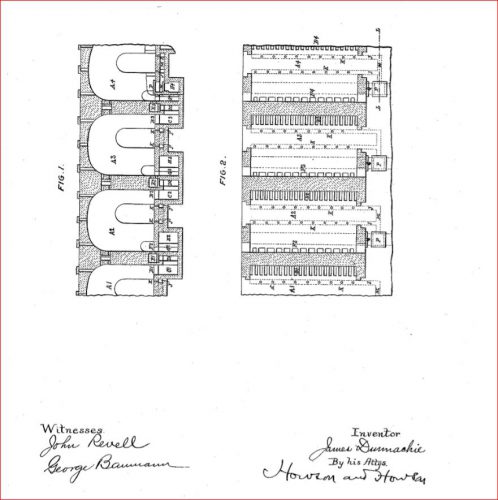
Below – 1891 – 1892 – Glenboig Union Fireclay Co Ltd. James Dunnachie – Manager. John Gray Secretary.
Below – 1891 – 92 – Glenboig Advert James Dunnachie Managing Director. John Trench – Secretary. Nocilis Silica bricks. Also, note “contractors to her majesty’s home and Indian Governments and the leading National Arsenals”
1894 – Glenboig Union Fire Clay Co attend the Antwerp Exhibition. Fire-bricks.
Below – 08/03/1894 – Dundee Courier – Dundee Gas Commission accept tenders. Prices given.

Below – 20/10/1894 – Glasgow Herald – Court case against the Caledonian Railway Company and the Glenboig Union Fireclay Company.
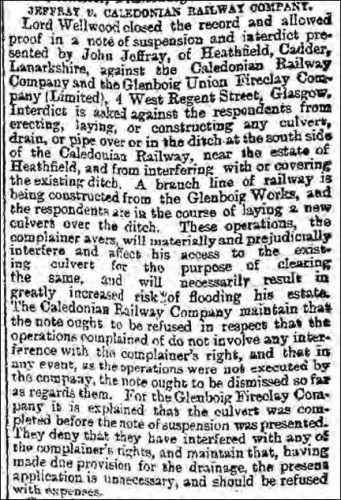
17/04/1895 – Kirkintilloch Herald – An importunate applicant. Robert Chapman, Glenboig, applied for a public house license for premises at Cumbernauld Station. The same application had been repeatedly made and often refused. Mr McFarlane appeared as agent for the applicant, while objections were urged by Mr Wark, on behalf of the Glenboig Union Fireclay Company, and by Mr McBryde on behalf of 69 petitioners resident within a radius of a mile of the station. One of the objections stated was that the applicant had already 3 licenses, 2 in Coatbridge and 1 in Glenboig. A vote was taken, when 20 voted for granting the license and 37 for refusing it. Provost Aitken and Messrs Cameron and Hudson voted with the majority, while Dr Stewart and Messrs Stables and Gardner voted for granting the license
30/10/1895 – Coatbridge Express – Joseph Dollan, (15), Chapelbank, Glenboig met within accident while employed in the Union Fireclay Brickworks on Monday week, two iron plates. weighing 2 1/2 cwts having fallen upon his legs, whereby be sustained a simple fracture of the right shin bone. He was attended to by Dr Marshall, Coatbridge, and removed to the Glasgow Royal Infirmary.
21/11/1895 – Glasgow Herald – The body of Edward Meaghen, about 30 years of age was found in the Upper Dock yesterday. The deceased had arrived in Grangemouth in the beginning of last week from Glenboig to superintend the loading of the vessel Duisburg with his employer’s bricks and had been missing since Friday night. As a cap was found floating in the dock on Saturday it was supposed that the deceased must have fallen into the water. A party with policemen made a search in the dock with grappling irons with the above results. The body was removed to the mortuary.
Below – 1896 – Advert Glenboig Union Fireclay Coy.
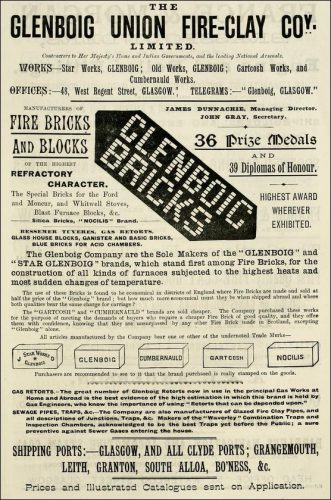
23/09/1896 – Dundee Courier – Dividends – Glenboig Fireclay Company at the rate of 7½%.
1897 – Link to a map of Glenboig showing the various brickworks.
19/10/1897 – The Scotsman – Brussels International Exhibition – The Diploma of Honour, an award higher than the gold medal has been given to the Glenboig Fireclay Union Company Limited at the Brussels International Exhibition for their exhibit of fire bricks and furnace blocks and 2 silver medals for sanitary and vitrified goods.
21/10/1897 – Glasgow Herald – The 15th annual meeting of the Glenboig Union Fireclay Company Limited … During the past year the company had acquired adjacent property and the works of Gartverrie and two subways were being constructed, one of which was intended to connect those works with Glenboig … Mr James Dunnachie elected as managing director …
23/03/1898 – Glasgow Herald – Joiners (2) wanted – steady men. Wages 30s per week. Apply to the Glenboig Union Fireclay Co Ltd, Glenboig.
20/09/1898 – Glasgow Herald – Bricklayers wanted. Wages 35s per week. Apply Glenboig Brickworks, Glenboig.
08/10/1898 – Dundee Courier – Glenboig Union Fire-Clay Company. The report of the Glenboig Union Fire-Clay Company for the year ending 31st August 1898 states that the sum at the credit of profit and loss account (including balance of £825 12s 6d brought forward from last year) is £16,210 8s 8d, from which there has been written off for depreciation £2000, leaving a nett profit of £14,2108s 8d. From this sum, it is proposed to pay a dividend of 10 per cent, (less income tax), payable on 10th November next. This dividend would amount to £13,500 and would leave a balance of £710 8s to be carried forward to the current year.
08/12/1898 – Daily Record – Issues have been ordered by the First Division in an action by Samuel Curran and others, the children of the late Robert Curran, labourer, Glenboig against the Glenboig Union Fireclay Company (Limited), Coatbridge, for £500 or £133 under the Employers’ Liability Act, as damages in respect of the death of the pursuers’ father, who on 10th May was run over by some waggons belonging to the Caledonian Railway Company (who are also called as defenders) and suffered injuries which led to his death. The defenders in both instances deny liability for the accident.
18/036/1899 – Airdrie and Coatbridge Advertiser – Settlement of Court of Session cases … as also the action by the children of the deceased Robert Curran against the same company (Caledonian Railway Company) for compensation for the loss of their father, who met his death in the Glenboig Fireclay Union Brickworks through a “flying shunt” in the clay-shed in May last. In both these cases the railway company have paid substantial amounts in satisfaction of pursuers’ claims.
Below – 31/08/1899 – Lloyds List – The daily register of British industries. The following classified list of British industries, containing the name of firms celebrated throughout the Kingdom for the various manufacturers for which they are associated, is compiled for the guidance of buyers in the different markets of the world.

Below – 11/10/1899 – The Scotsman – Glenboig Union Fireclay Company Limited annual report.
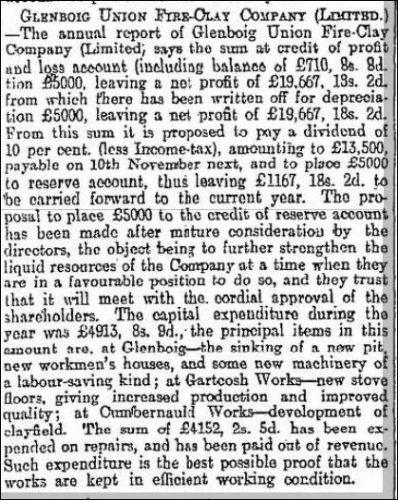
19/05/1900 – Bellshill Speaker – Motherwell and Bellshill Railway Bill … Mr James Dunnachie, managing director of the Glenboig Union Fireclay Company Limited, Cumbernauld, Gartcosh and Glenboig said his firm had the experience of competing lines at Glenboig and they found the competition resulted in a reduction of rates and various other benefits …
01/09/1900 – Kilsyth Chronicle – Shocking Accident Glenboig. A labourer named James Harper, (54). residing Southbank, Glenboig, has been run over and shockingly mutilated on a lye of the railway in the Union Fireclay Company’s Works, Glenboig. He had been in the act of cleaning a drain-pipe in the four-foot way when some waggons came upon him. He was dead when found.
and
The Glenboig Union Fireclay Company, Ltd., have been awarded a gold medal for their exhibits of fireclay goods at the Paris Exhibition.
1901 – Directory of clay workers – Glenboig Union Fireclay Company Limited. Works – Glenboig, Cumbernauld near Gartcosh. Head office – 48 West Regent Street, Glasgow. Fire bricks and furnace blocks, gas retorts and all types of settings, chimney cans, vent linings, ridge tiles, stable and causeway bricks, paving and byre crup tiles. T. add Glenboig, Glasgow. Tel 1009 National.
1901 – The clay miners went on a strike, broken only after 10 long months when the management brought in blackleg labour.
12/01/1901 – Dundee Evening Post – Lanarkshire miners to strike … Applications by Glenboig fireclay miners for permission to strike work for advance of wages was considered, and was agreed to obtain the decision of the county to striking work in this case also before deciding the matter next Thursday …
Below – Feb 1901 – Glenboig Advert.
17/07/1901 – Kirkintilloch Herald – Saturday night in the village – On Saturday last, when the “Journal’s” commissioner again visited the village, he found the strikers enjoying a well-earned relaxation after the excitement of the previous Wednesday. An equally contested football match was attracting the attention of younger bloods, while the scores of older men were at peace with the world in the collier like the recreation of sitting on their “hunkers” at the corners and doorsteps. Others and these, for the most part, were brick-workers, labourers, and blacklegs who were finding pleasure in partaking of “flowing bowl” in the village pub. The women folks, proud in the possession of their men’s ailment or dearly-bought wages were making preparations for a journey to the Brig to lay past the weeks provisions. Policemen patrolled the rows, and inwardly anathematized everything and everybody, for in these troublous days the lot of the Glenboig policeman is not cast in pleasant places. In the afternoon there were no indications of any trouble or disorder, but as the day advanced, and the visitation of the blacklegs to the village hostelry became very frequent and prolonged, things took a livelier turn. Suddenly the cry of “police” was raised, and a general rush was made to the Station Road. Here a sturdily-built workman, whose clothes were besmeared with blood, and whose head was a mass of cuts and bruises, was being borne home by a few boon companions. It transpired that he was a blackleg and that in return for some insolence he had been assaulted, somewhat brutally, by a person or persons unknown. The police set to investigate the matter, and the result of their inquiries was subsequently communicated to the “Journal” man. “I am afraid sir,” said the constable, “this incident must be written down in the books as another strike mystery. The assaulted person is an ex-army man, and a blackleg to boot. He has a very hazy recollection of what occurred, while his companions, who are his fellow-lodgers ad fellow-blacklegs, are equally as dense. judging from their present state of unfitness, it is now possible to get at the culprits from that side, and you can believe it’s most unlikely we’ll get anything from the strikers. Mind you I have the firm belief that the strikers know something about this. But scenes like these are of very frequent occurrence just now.” In the course of the conversation, the policeman remarked to our representative that his sympathies were entirely the strikers. “It’s a crying shame,” he added, “that men like that (pointing to an unwashed, unshaven, slightly elevated, and tattered parasite) should be sent here to disturb the peace and respectability of the village. Would you believe it, sir, but these men, although they have worked together for two months now, don’t know each other’s names. Some of them claim to be of English extraction, but I know different – they’re from the old country. I’m an Irishman myself, and I’m right down sorry that louts like these have been guilty of another injustice to Ireland. It would, indeed, be a pity if they openly acknowledged that they hailed from the Emerald Isle.” “And what about the Poles.” interjected our representatives. “It strikes me rather forcibly,” said the officer, “that the motto of the Poles should be for the hostile demonstration that took place. ‘nemo me imputie lacessit,” and for the reason that the strikers stand in mortal fear of these foreigners. The Glenboig Pole is constantly armed with a bottle, and if he’s interfered with, then a thousand pities on the poor devil who is daring enough to do it.” Proceeding to recapitulate some of the scenes at the evictions the constable held the opinion that the Sheriff officers had themselves solely to blame for the hostile demonstration that took place. Although these minions of the law had passed the sergeant of police at Glenbiog Station they never once thought of acquainting him with the object of their mission. “And I can assure you,” added the officer, in an undertone. “I was mightily glad to see them taking shelter in that hay shed yonder.”
24/08/1901 – North East Lanark Gazette – The Glenboig Dispute – In Glasgow Sheriff Fyfe on the bench, two respectable-looking men, named William Brown, senior., and John Leonard, were charged with intimidation in connection with the dispute at Glenboig Fire Clay Works. The indictment bore that the accused tried to compel certain men to desist from working at the clay works at Heathfield, by cursing and swearing at them and breaking some panes of glass. Both men pleaded guilty, and Mr Shaunessey, who appeared for them, explained that the case arose out of the strike that had been going on at Glenboig for some time. A number of Poles had been taken on to replace the men on strike, and this had exasperated the accused. One of them had been employed at the works for 32 years, and the other for 12 years. They were married men, one of them having 11 children and the other five. They were well-behaved and had never been in trouble before. Mr Brander, who prosecuted, said that the intimidation was very serious at the time, and several of the Poles against whom it was directed had, through fear, to take shelter beneath the beds in their houses. Sheriff Fyfe reminded the accused that the penalty for such a one-off as they had been charged with was three months imprisonment. There was a mistaken notion among trade unions that so long as no violence was used there was no intimidation. He would like to impress upon them that that was a mistake. No doubt the employment of Poles exasperated the men, and his Lordship was willing to make every allowance for them. At the same time, he pointed out that the Poles had a perfect right to work, and the accused might understand, and let their colleagues understand, that this kind of intimidation would not do. He would, however, impose a modified penalty in their case, and fined each of them £8. The fines were paid.
24/09/1901 – Dundee Courier – Glenboig Union Fireclay. The accounts of the Glenboig Union Fireclay for the year ending 31st August last after providing for the maintenance of works and all current charges, and including £1982 16s brought forward from the previous year show, subject to completed audit a gross profit of £17,902 5s 4d. The directors at their meeting today agreed to recommend to the shareholders at their annual general meeting to be held next month that the same be disposed of in the following manner:- For depreciation on capital expenditure£3000; in payment of a dividend at the rate of 10 per cent., £13,500 leaving a balance to be carried forward of £1402 5s 4d – £17, 902 5s 4d.
Below – 17/10/1901 – The Scotsman – The nineteenth annual meeting of the Glenboig Union Fire-Clay Company (Limited) was held yesterday in the company’s offices at Glasgow. Mr John Wilson, chairman, presiding. The chairman in moving the adoption of the report, which had been published, said the directors were very glad, all things considered, that they were able to meet the shareholders with such a satisfactory balance sheet as was presented to them on this occasion. They had had rather trying times during the past year on account of the strike, which dislocated the business of the company for ten months out of the twelve; and it was very surprising that they had made the profit they really had done. There was, perhaps, an explanation for that. The stock of the previous year was taken at a very low figure and on account of the works being nearly wholly stopped the directors thought it wise that in the event of people insisting that they should be supplied with the Glenboig brick, the company should get a fair price for it. Dealing with the accounts, he said that the balance, including what was leftover from the previous year, was £17,902. The depreciation account had been written down £3000, leaving a nett profit of £14,902. From this sum the dividend of 10 per cent. took £13,500, leaving the very respectable sum of £1402 to be carried forward to the current year. The capital expenditure had been £3915. That had been largely caused by the company considering the necessity of extending their mineral field and looking around them to see that they got a proper field of clay in the immediate vicinity. The pretty large sum of £4734 which had been paid out of revenue, had been spent on repairs and the reason for it being pretty heavy was that when the works were standing, the manager took the opportunity of doing all the repairs he possibly could, so as to have them in good order when they were again restarted. During four months the miners restricted their work to four days a week and for about six months afterwards they stopped work altogether. It was a very hard lines on the company. They were paying the very top wages that were going and the miners were getting good wages and altogether the strike was of a most unsatisfactory nature. They did not hurry the workmen in any way by insisting upon them going out of their houses before they had ample time to do so. Other men had now been got to work the minerals of the pit and he was informed that the company were putting the stuff out cheaper than they did with the old hands, and were getting many things done that the old hands would not do. These old hands considered they were as much the managers of the mine as the manager himself. The works were again in full operation and that must be very gratifying to the shareholders. Notwithstanding the strikes, they had not been under the necessity, in order to pay the dividend, of touching the reserve fund. They had not added anything to it, and it still stood at £7000, but he hoped that before another annual meeting they would be able to substantially increase that sum. Mr James Craig seconded, and the report was adopted. Mr Dunnachie, managing director, in answer to questions, said that the new men were not members of the Lanarkshire Union. He thought there was a fair return for their expenditure on workmen’s houses. In reply to the remark of another shareholder that they had only taken off £3000 for depreciation this year, while last year the sum was £5000, Mr Dunnachie said that last year the sum was more than was necessary. In order to steady the dividend they had to vary the amount, but he thought £3000 was a good average for depreciation. A shareholder asked whether the directors had considered taking over of the Garnkirk Works. Mr Dunnachie replied that that matter was brought up when the Garkirk Works were being advertised but the directors did not think it desirable to take them over. The price was much lower today and at their next meeting the matter might probably be referred to again, but he thought the result would be the same as it was before. The report was adopted. Mr James Craig and Mr Matthew G Wilson were re-elected directors and the auditors having been reappointed the meeting ended.
24/09/1902 – Kirkintilloch Herald – Glenboig Fireclay Company. The accounts of this company for the year ending 30th Aug., after providing for the maintenance of works and all current charges, and including £1402 5s 4d brought forward from the previous year, show, subject to completed audit, a gross profit of £21,550 16s. The directors at their meeting on Friday agreed to recommend to the shareholders at their annual general meeting to be held next month that the same be disposed of in the following manner:- For depreciation on capital expenditure, £400; to reserve account £3000 in payment of a dividend at the rate 10 per cent., £13,500; leaving a balance to be carried forward of £1056 16s.
Below – 1903 – James Dunnachie points out the positives of using his Dunnachie kiln as opposed to a ‘kiln of Dunnachie type’! See page 500
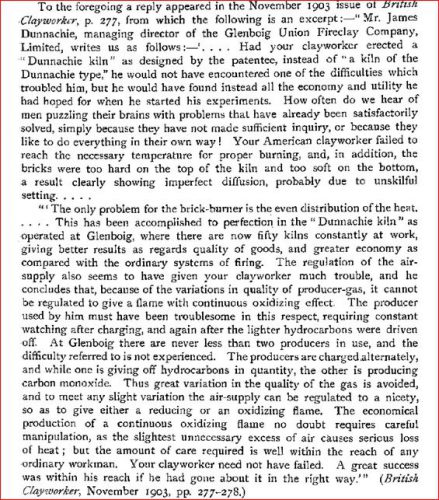
Below – March 1903 – Glenboig Advert.
17/10/1903 – Aberdeen Press and Journal – Glenboig Union Fireclay Company – A meeting of the shareholders of the Glenboig Union Fireclay Company was held yesterday in the company’s offices, Glasgow -Mr John Wilson, the chairman, preceding. Mr Richard Baxter, the secretary, read the notice calling the meeting. The Chairman, in moving the adoption of the report, congratulated the directors and shareholders upon its favourable character. It was the most favourable report that the directors had had the pleasure of submitting to the shareholders. The balance on the credit and loss was the largest in the history of the company. The directors had been able to write off £5000 for depreciation, they had debited revenue with the large sum of nearly £6000 for repairs, and over and above they had added to reserve the large sum of £5000; and above all, they were able to pay a dividend of 10 per cent, and to carry forward to next year £2764. The amount standing at the credit of reserve was now £15,000. This enabled the directors to carry through a very desirable operation. It enabled them to get rid of the liability for a further call upon the shareholders, as the £9 shares would after this be represented at £10 fully-paid shares. The dividend of 10 per cent, would be subject to income tax, but the bonus of £1 per share which the directors had decided to get rid of the liability of £1 per share at present existing on the company’s stock would be free of income tax. Mr James Craig, Kilmarnock, seconded.
1904 – Petone Borough Council, New Zealand – Evening Post, Volume LXVIII, Issue 100, 25 October 1904, Page 6 – purchase of Glenboig retorts for making gas.
Below – 1904 – 1905 – Glenboig Union Fire Clay Co advert.

1906 – Marlborough Express, Volume XXXIX, Issue 83, 9 April 1906, Page 3 – Malborough, New Zealand town budget refers to outlay for Glenboig bricks.
27/10/1906 – Airdrie and Coatbridge Advertiser – Triple Scotch award at the Milan International Exhibition. The Diploma of Honour and two gold medals have been awarded to the Glenboig Union Fire Clay Company Limited, for their exhibit at the Milan International Exhibition, 1906, being the highest award for fireclay goods.
Below – 1907 – Glenboig Union Fireclay Co advert.
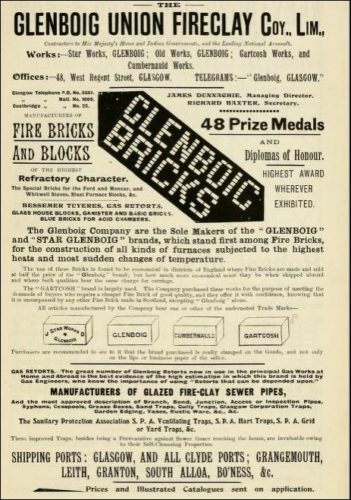
Below – 1908 – Illustrated album of the International Building and Art Exhibition St Petersburg. – From the Ministry of Trade and Industry Bronze medal 6. Glenboig Factory for firebricks. (Many thanks to Vladimir Smirnov for sending me this and the translation)

21/10/1908 – Daily Record – The international jury at the Franco-British Exhibition have awarded the Glenboig Union Fireclay Company Limited. the diploma of honour for refractory bricks and a diploma of honour for gas retorts.
1909 – Archibald Henry Dunnachie died in February 1909.
He was a son of Mr James Dunnachie and was the general manager of the Glenboig Union Fireclay Company Ltd., at Glenboig. He had had a wide experience in some of the largest steelworks in France and was much interested in the chemical aspects of the refractory materials industry, and ably supervised the well-equipped laboratory installed at Glenboig. He was elected a member of the Iron and Steel Institute in 1890.
1909 – Much of the work was dirty, hard, and dangerous. One accident, in 1909, resulted in four clay miners being killed after an underground roof fall.
Below – 1909 – Glenboig Union Fireclay Company Ltd advert. Manufacturers of fire clay goods of every description – Sole Makers of the “Glenboig” and “Star Glenboig ” Brands of Fire Bricks, also the ” Cumbernauld ” and ” Gartcosh ” Brands. Blue Bricks for Acid Chambers— “CONTACIC Brand. Glenboig Ironstone Corrugated Tile for Railway Stations. Special Bricks for Forge, Rolling Mill, and Puddling Furnaces. The Siemens-Martin, the Bessemer, and the Thomas-Gilchrist Furnaces. Copper Roasting, Calcining, and Refining Furnaces. Gas Retorts and Special Bricks for all the best modern Retort Settings. Special Bricks for the newest kinds of Coke Ovens. Class and Chemical Furnaces; Blast Furnace Blocks. Glazed Sewage Pipes, Patent Junctions, &c. Works: Glenboig (Old Works). Glenboig (Star Works). Cumbernauld Works. Gartcosh Works, Glebe Street Head Offices: 48 West Regent St., Glasgow.


Below – 1909 – The history of this company practically dates back to 1836, when an extensive basin-shaped deposit of siliceous clay was discovered at Glenboig. As this kind of clay is valuable in the making of fire bricks and other adjuncts necessary in the construction of the furnaces in the great Lanarkshire iron field, a small factory was started. It speedily took the premier position for furnace building in the district and formed the nucleus of the vast industrial combination which forms the subject of this notice. In 1860 the present managing director of the concern, Mr James Dunnachie, who was then a young man of twenty- five joined the business, which was that year started under the firm name of Thomson, McLean & Co. From that date, the business continued to increase by leaps and bounds, and in 1865 it passed into Mr Dunnachie’s hands; he assumed two partners, and the business was carried on under the designation, “The Glenboig Fire-Clay Company” till 1872, when the firm was dissolved. In that year Mr Dunnachie leased the unlet portion of Glenboig, consisting of six-sevenths of the whole, and erected the ” Glenboig Star Works,” which in three years became the largest producer of fire-clay goods in the kingdom. One of the partners of “The Glenboig Fire-Clay Company” carried on the old works till 1882, when the two concerns were united under the present name of “The Glenboig Union Fire-Clay Company Limited,” with Mr Dunnachie as managing director. Since the amalgamation, which put an end to a rivalry of ten years, two other works have been acquired at Cumbernauld and Gartcosh, so that the whole forms the largest combination of the kind in Europe. Many notable firms using their fire-bricks attest to the truth of the Company’s claim that these products are more durable, more reliable, and more economical than the ordinary brands of fire-bricks. One of the greatest improvements in the manufacture of Glenboig fire-clay goods was affected by the introduction of ” Dunnachie’s continuous regenerative gas kiln,” which reduced the cost of burning the more strongly resisting materials by one half, completely abolished smoke and greatly increased the quality of the products. The Company’s output, which is singularly varied, includes all shapes and sizes of bricks, blocks, tiles, etc., required for the Siemen’s and Bessemer steel furnaces, puddling, and blast furnaces; Ford & Moncur’s, Cowper’s, and Whitwell’s stoves, Bauer’s coke oven, Klonnes furnaces; Siemen’s, Duff’s, Mond’s, Wilson’s, and other gas producers, steel-smelting furnaces, Gorman tubes, runners, plugs, tuyeres, etc., etc., also blue bricks for acid chambers and gas retorts; together with every variety of settings, glazed sewage pipes, cattle troughs, paving tiles, and, in fact, all kinds of articles which come under the designation of fire clay goods. These are supplied to all the markets in the civilised world. Some idea of the excellence of the Glenboig articles may also be gained from the fact that they have been awarded fifty-six medals and diplomas of honour at the principal exhibitions. Over a thousand hands are employed in the works and the population of Glenboig has increased from 120 persons, in 1860, to over 3000 today, most of whom are more or less closely associated with the Company. So long as the Company is under the present direction its prosperity is assured, for the wealth of material in the Company’s clayfields is practically inexhaustible and of the same unrivalled quality as that which first made the “Glenboig” products famous.

20/03/1909 – Coatbridge Leader – Glenboig fireclay. Professor J. W. Gregory read a paper at a meeting of the Royal Society, Edinburgh, on Monday on the Glenboig fireclay. He said Glenboig fireclay must have been laid down as a lagoon deposit as shown by its mineral composition. One of the most interesting minerals found in the clay was a carbonate of iron and magnesium, known as sideroplesite, which was formed by crystals in the waters of the lagoon, and subsequently enlarged by the addition of fresh water when lying on the floor. The absence of china clay from Scotland had been used as a strong argument, in favour of the deep-seated formation of china clay. The locality of the tuesite, where it was found, had, however, been re-examined. and instead of the material being in beds as described it occurred in veins in a volcanic neck. That evidence was, therefore, quite consistent with the deep-seated formation of china clay.
Below – September – October 1909 – Glenboig Advert.
09/10/1909 – Edinburgh Evening News – The annual meeting of the Glenboig Union Fireclay Company was held in Glasgow yesterday. Mr Dunnachie presided and in proposing a dividend of 8%, said they had suffered from the general depression of trade but the prospects were now brighter, their order book being well filled at good prices. The installation of electric power had proved beneficial and they also expected good results from the arrangement for the equalisation of dividends. The resolution was adopted.
Below – 1910 – Trading House selling foreign bricks in St.Petersburg in 1910.

Below – 15/04/1910 – London and China Express – Glenboig Advert

27/08/1910 – Airdrie and Coatbridge Advertiser – On Tuesday night, James Butters (35). a labourer, 11 Southhank, Glenboig met with an accident while emptying a hutch of firecley down the shoot into the clay mill within the Old Works, Glenboig, occupied by the Glenboig Union Fireclay Coy., Ltd. He received a simple fracture of both bones of the left leg below the knee by being jammed between the buffer of a loaded hutch which came behind him unseen and the rail of the iron tumbler on which the hutches are emptied. He was attended to by Dr Moffat. who set the leg, and had the man removed to Glasgow Royal Infirmary in Coatbridge by ambulance waggon.
06/10/1910 – Airdrie and Coatbridge Advertiser – To let. Inchneuk Farm, New Monkland from Martinmas 1910 for such period as may be agreed upon. The farm extends to about 80 acres or thereby and is adjacent to Glenboig Village. For further particulars apply to the Glenboig Union Fireclay Company Limited, Glenboig.
Below – December 1910 – Jan 1911 – Glenboig Advert.
Below – 28/02/1911 – Clyde Bill of Entry and Shipping List – Glenboig Union Fire Clay Advert.
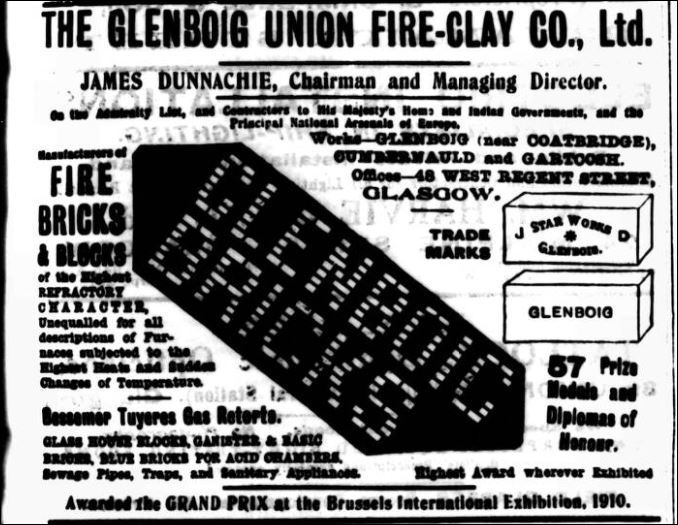
29/04/1911 – Airdrie and Coatbridge Advertiser – Glenboig Fireclay as a mineral. In the House of Lords on Thursday the Lord Chancellor and Lords Macnaghten, Shaw and Robson commenced the hearing of an appeal by the Caledonian Railway Company, the respondents being the Glenboig Union Fireclay Company (Limited). The appellants sought to interdict the respondents from working beds or seams of fireclay or clay in the land, of Gartverrie and Ramoan underneath or adjacent to the Castlecary and Garnkirk branches of the appellant’s railway near to Glenboig Station. The question for decision is whether the beds and seams of fireclay of which the respondents are tenants are so far as situated in the lands acquired by the appellants to be deemed to be excepted out of the conveyances in favour of the appellants as falling within the exception of mines of coal, ironstone, slate, or other minerals under the lands purchased by the appellants within the meaning of Section 70 of the Railway Clauses Act, 1845. In short, the question is whether fireclay is a mineral within the meaning of that section. The appellants submit that the fireclay in question is not a mineral within the meaning of the Railway Clauses Act, in respect of that it is a common rock of the district and forms the substratum of the soil with, no doubt, other kinds of rock intermixed. They further submit that the fireclay is part of the subjects purchased by them when they acquired the lands. The respondents, on the other hand, maintain that the fireclay is a mineral within the meaning of the Act of 1845 and that the fireclay in question is excepted from the conveyances in favour of the appellants. The Lord Ordinary refused the interdict and the First Division upheld this decision. Against these judgments of the Courts below the present appeal is taken to the House of Lords. Mr . Clyde had not finished his speech opening the case for the appellants when their Lordships adjourned. The Lords heard further proceedings in the case yesterday, and at its conclusion dismissed the appeal with costs.
06/05/1911 – Airdrie and Coatbridge Advertiser – Wanted. Engineer for brickworks machinery and electric pit pumps. Apply by letter to The Glenboig Union Fireclay Coy Ltd, Glenboig.
Below – 1912 – Glenboig Advert.
Below – 1912 – Glenboig Advert.
15/05/1912 – Kirkintilloch Herald – A a result of negotiations between the workmen and the companies concerned the workmen in the Glenboig Fireclay Works have been granted an increase 1s per week on their wages. The women workers have been conceded 6d per week.
Below – August 1912 and Feb 1914 – Glenboig Advert.
06/03/1912 – Kirkintilloch – … The strike is having a serious effect on the other industries in the district, work having been suspended at the works of Heathfield and Cardowan Fireclay Co Ltd, Heathfield; The Glenboig Union Fireclay Coy Ltd at Gartcosh, Glenboig and Cumbernauld; Messrs P & M Hurll’s Ltd Brickworks, Glenboig …
Below – 1913 – Photo depicting workers at the Old Glenboig Brickworks – Source unknown.

Below – Feb – Apr 1913 – Glenboig Advert.
18/10/1913 – Airdrie and Coatbridge Advertiser – Glenboig Union Fire Clay Company – The annual meeting was held in Glasgow on Friday, Mr James Dunnachie presiding. The Chairman said that the year that ended August 31 last was the best year they had had, both as regarded to the amount of business done and the profits made. From the beginning, each year of the company had shown an increased turnover compared with its predecessor. In the year just closed the increase was much greater than usual. That required some little explanation. Fully three years ago, when their mining operations were approaching the Caledonian Railway main line at Glenboig, the railway company interdicted them from working below the railway. They gave two reasons for that. The first was that it would endanger the stability of the line. On that point, their company were at one with the Caledonian Company. The second reason was that the clay belonged to them, and not to the Glenboig Fire-Clay Company. They differed from the railway company on that point. There was an attempt made amicably to arrange matters, but ultimately the question had to go to the Court of Session, and afterwards to the House of Lords. At each stage, the decision was given in favour of the Glenboig Company. That settled the question as to who was the owner of the clay. Then the question came to be what was the price to be paid if the clay was to be left for the safety of the line. That was settled by arbitration, and the amount their company got would enable them to pay, as proposed, a bonus to the shareholders of £1 per share. In reply to questions, the Chairman stated that the price they got from the railway company for the clay left in was £15,000. Their books were full of orders at good prices, and he thought the prospects for the year were excellent. The report was adopted.
30/01/1914 – Forbes Advocate – Forbes Gasworks New South Wales … The only recommendation I would make at this time is that 1 bed of 4 retorts be rebuilt and that 4 Glenboig retorts and 2,000 firebricks be imported for the purpose. The retorts will cost £9/10/- each and the firebricks about £10 per 1,000 … Alderman Raymond was informed that the firebricks had to be imported as the Australian made ones would not stand the heat.
21/10/1914 – Dumfries and Galloway Standard – The sanitary equipment of Dumfries is being improved by the provision of a refuse destructor, now in course of erection in Burns Street. This latest acquisition is expected to be in working order in the course of a few weeks. By means of the destructor, the whole of the town refuse will be cremated at the rate of fifteen tons in twelve hours. This is an advantage that cannot be overestimated, especially it strikes the knell of the old insanitary method of dumping refuse in suburban and country areas … The outside walls are faced with enamel firebrick, and the interior is lined with the best quality of Glenboig firebrick. The doorways are built of special firebrick blocks, and the arches, which are constructed quite independently of the walls, are built of special tapered bricks. It will be noticed, therefore, that the brick building is a notable feature of the work, and it undoubtedly reflects much credit on the contractors. The chimney is erected Custodi’s patent system, with firebrick lining quite distinct from the shell, which is of special thickness …
Below – 1915 – 1916 – Glenboig Union Fire Clay Co advert.
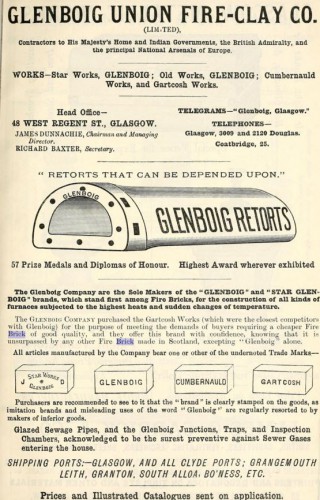
25/03/1916 – Airdrie and Coatbridge Advertiser – Blacksmith wanted. Good jobbing man wanted. Apply The Glenboig Fire Clay Works, Glenboig.
15/08/1917 – Kirkintilloch Herald – Eastern District local tribunal … Protected men. In the case of two men with the Glenboig Fireclay Company, and one man with the Cadzow Coal Company at Wester Gartshore, the conditional exemption was withdrawn, as the men are now protected by a trade card …
c.1919 – The Glenboig Union Fireclay Company operated Castlecary Fireclay Co; … Faskine and Palacerigg Bricks and Coal; … George Turnbull and Co – Bonnymuir and Dykehead Works.
Below – 1910 – St Petersburg Times – Trade House “Grabovsky” represents the exclusive sale of the highest quality British firebricks Glenboig Star Works in Russia. Annual import of 20 000 000 pud. The advert mentions other imports such as cast iron so the weight of goods imported appears to refer to everything rather than just the Glenboig firebricks. (1 pud = 40 pounds weight)( Many thanks to Vladimir Smirnov for this information)

11/07/1920 – Sunday Post – Curious Glenboig ejection case – Airdrie, Saturday. A singular case of summary ejection was called before Hon. Sheriff Forsyth in the Sheriff Court at Airdrie today. The Glenboig Union Fireclay Company sought the removal of John Hourigan from the house he occupies, which belongs to the pursuers. Mr Bell, for the company, stated that Messrs Baird Co., Gartsherrie Ironworks, had sub-let certain houses to the Glenboig Company till such time as they (Messrs Baird) required them for their own workmen. The houses were now required for Messrs Baird’e employees, and this was one of them. Defender was a sub-tenant under the Glenboig Company, but although the latter offered him another house he would not quit the one he was in. Defender told the Sheriff it wasn’t him who had the house from the Glenboig Company; it was his son, with whom he was only a lodger. The Sheriff —Is your son in the house just now? Defender —Yes. I have got nothing to do with the house. Mr Bell —Why don’t you leave the house? Defender—l cannot leave the house. I am only there as a lodger. It’s not me that pays the rent. He added that the summons was left for him at his son’s house, but should have been for his son. The Sheriff said in that case it would do the present defender no harm to have decree of ejection passed against him. The pursuer’s agent would have to see whether he required to bring another action against Hourigan’s son.
1921 – The Glenboig Union Fireclay Company employees gave a reception for J. D. after 60 years of service to Glenboig. In his speech of thanks, the 85-year-old Dunnachie recalled how Glenboig had been a hamlet of 120 inhabitants and how it had grown to a thriving community of 3000-4000 people with its own railway station, churches, shops and a world name for firebricks. Ten days later James Dunnachie died and was succeeded by his son.
14/01/1921 – Kilsyth Chronicle – Mr James Dunnachie, chairman and managing director of the Glenboig Union Fireclay Co., Ltd., died at Glenboig House Saturday. Mr Dunnachie, who had reached the ripe age of 85 years, was associated, with industrial enterprise in Glenboig and South Cumbernauld districts for the past 60 years. The company over which he presided is probably the largest of its kind in the United Kingdom. As recently as the close of last month his record as a manufacturer and employer was recognised by the Fireclay Company’s employees and friends at a social gathering held in the Glenboig Institute. The function was a notable expression of the harmonious relationship existing between employers and employed and the illuminated address, presented along with other gifts, contained the following complimentary passage: Wherever at home or abroad, fireclay is intelligently worked, your name is familiar, particularly as the pioneer of the successful application of gas to the burning of fireclay goods and pottery.” Mr Dunmchie who was a native of Pollokshaws, was a discriminating collector of the Fine Arts and was a generous contributor to the loan collection of pictures at the 1901 Exhibition in Kelvingrove Park, Glasgow. During the war, his initiative on behalf of the British Red Cross Society’s work was instrumental in securing the main hall of the Glenboig Institute a war hospital with accommodation for 60 beds.
15/01/1921 – Coatbridge Leader – We regret to report the death of Mr James Dunnachie, chairman of the Glenboig Union Fireclay Company, Ltd., who died at Glenboig House last Saturday, aged 85 years. As managing director of the important concern which has made Glenboig famous, Mr Dunnachie was very well known in Coatbridge and the district. During the war, he did much good work on behalf of the Red Cross Society, which, thanks greatly to his good offices, was enabled to convert the Glenboig Institute Hall into a commodious hospital; and the high esteem in which he was held by employees and friends was manifested only last month when they presented him with a handsome testimonial and illuminated address.
Below – Glasgow Necropolis – James Dunnachies gravestone.
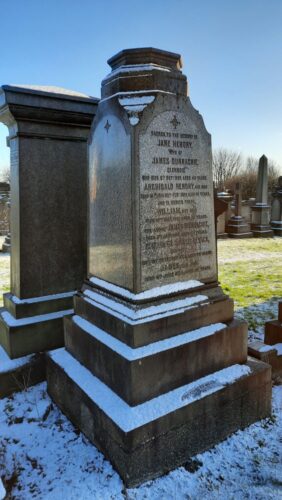
Below – 25/01/1921 – The Scotsman – Court of Session. Glenboig Union Fireclay Co Ltd V Commissioner of Inland Revenue. Glenboig Union owned Gartverrie Fireclay Works and in 1908 clay excavations near the railway was stopped by a court order following a complaint from the railways. Subsequent court cases awarded Glenboig Union £26, 230 in compensation. The Inland Revenue thereafter taxed same and the Glenboig Union took the IR to court.
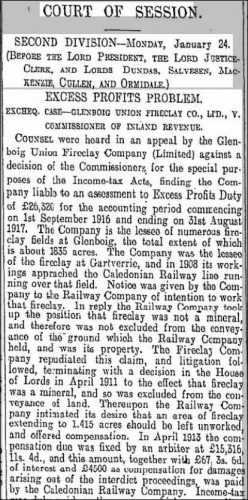

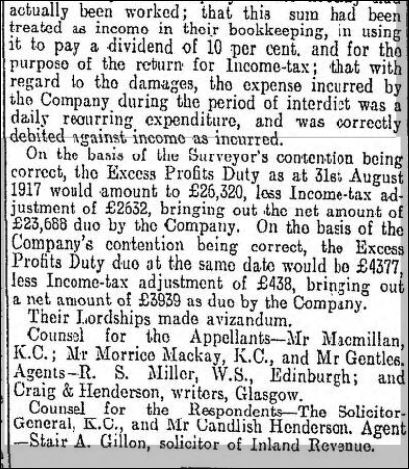
11/04/1921 – Daily Record – A fire which broke out in two sheds in Glenboig Union Fireclay Company’s works destroyed a large store of hay, straw and moss litter. A lorry was also destroyed.
15/09/1922 – Kilsyth Chronicle – Warrants were granted against Francis Neilson, carter, Salisbury Street, Glasgow charged with trespassing in a salt house of the Glenboig Union Fire Clay Company at Cumbernauld, and Sarah Daly or Hughes, widow, Wynd, Cumbernauld, charged with being drunk and disorderly at Cumbernauld 3rd July.
17/11/1922 – Kilsyth Chronicle – Compensation for a man who fell down an embankment. An interesting claim for compensation brought in the Airdrie Sheriff Court by William Reid, kiln burner, 13 Brickwork Rows, Gartcosh, against Glenboig Union Fireclay Coy., Ltd., has been decided by Sheriff Macdiarmid. The pursuer claimed £1 per week under the Workmen’s Compensation Act account of his having accidentally fallen over a railway embankment in the darkness and been totally, incapacitated for work. The Sheriff says there was no doubt that the man did not know (in the darkness) the recognised way from the producers, where he had been at work, and there was no question of serious or wilful misconduct in not going out the recognised way. When he went beyond the timekeeper’s office, and when fell over the embankment on the branch line, he was still within the works, not on his own business, but that of his employers, the business being an endeavour to get out the works.
24/10/1923 – Kirkintilloch Herald – Mr. James Donnachie, who presided over the forty-first annual general meeting of the Glenboig Union Fire-Clay Co.. Ltd., last week, submitted the statement of the directors, which recommended the payment of a dividend of 20 per cent, on October 26th. In doing so, he described the year as one of much depression. The prosperity of the fire-clay trade depended very largely on the prosperity of the iron and steel trades, and in the year under review, these trades had been practically stagnant. At the beginning of the year, there were signs that business was extending, but their hopes were shattered by unforeseen circumstances. The Continental trade was developing satisfactorily until the political situation of the Rhur cut out a large area in which they operated. Then there were the railway and dock strikes in Belgium which hung up trade both in Belgium and North France. The ordinary capital expenditure for the year was £l000, while the sum expended on repairs and renewals paid out of revenue amounted to £13,600. The motion was seconded and agreed to, and the retiring directors, Messrs. R. Suttie and D. Craig, were unanimously re-elected.
Below – 17/09/1925 – Belfast News Letter –

01/06/1928 – Kirkintilloch Gazette – New works, Glenboig – A site of 20 acres has been acquired north of Glenboig Station and adjacent to the Glenboig Union Fire Clay Company’s Star Works by an American Syndicate, the Bussey Coal Distillation Company (Limited), and large works will be erected for the purpose of distilling coal and selling oil and other byproducts. It is anticipated that the incoming and outgoing material from the works will reach almost 1000 tons per day. The main industry of the village is fire brick manufactory carried on by the Glenboig Union Fire Clay Company and P and M Hurll (Limited). The depression in the steel trade has, however, been very much felt in the Glenboig district, though employment has been better than in many places owing to the large export of fire brick and other material. Messrs Bussey intend to commence operations immediately, and when their plans have been fully developed the scheme will, it is believed, give employment to a large number of workers. The preliminary work will, it is expected, more than absorb the unemployed of the district.
Below – 02/02/1929 – Falkirk Herald – Bust of the National bard. Work of the late Mr John Douglas, Fireclay Works manager, Glenboig Fireclay Works. Mr Douglas died in August 1928. – Our picture is from a photograph of a bust modelled in clay the late Mr John Douglas. Every statue and print the poet available was carefully studied, and the variety of likeness in these was arresting – scarcely two quite agreeing. Before completing his congenial task with the above, Mr Douglas ruthlessly broke some dozen prior attempts to fix the elusive features before his critical eye was satisfied with his hand’s work. The above result perhaps leans to the ideal but that is common at present, and Mr Douglas, in his own medium, is only in line with speakers. He was a keen admirer of the bard and delighted to tell how an ancestor of his own used frequently see him passing her door in Ayrshire, lying on his back on top of a load of coal. His face to the with an absorbed look and some book in his hands—the horse ‘gangin’ his ain gait. Douglas had many friends and admirers in Bonnybridge district, and it was well known that commerce was fortunate in having his services when art might well have been triumphant.

04/03/1929 – The Scotsman – … In a Glasgow newspaper yesterday there appeared a report that depression in the fireclay industry had led to the suspension of the underground workers at the South Cumbernauld and Glenboig mines of the Glenboig Union Fireclay Co for an indefinite time. I am informed by a Unionist official in Glasgow that he has received a letter from the managing director of this company which states that one of the Company’s mines at Glenboig has been closed down for probably two months to carry through some developments. The letter goes on to explain that the men who have been displaced underground are employed in lifting the raw material above ground and adds that there is very much less unemployment in Glenboig now than there was a year ago …
09/10/1929 – Yorkshire Post – Company reports – Glenboig Union Fireclay – Including £4,218 brought forward, profits for the year ended August were £15,000. A dividend of 7 1/2 per cent is proposed, placing £1,000 to depreciation, £1,500 to taxation reserve, and carrying forward £4,000.
1930 – Glenboig Union Fireclay Co Ltd purchase the mineral rights held by the Greenfoot and Gain Sand and Fireclay Works, Glenmavis.
22/10/1930 – Edinburgh Evening News – Presiding at the annual directors’ meeting of the Glenboig Union Fireclay Company Ltd., in Glasgow today, Mr James Dunnachie said that the company was in a thoroughly sound position. The drop in the company’s profits for the year, he said, was due entirely to the depression in trade in the country. From the latest information, he learned that out of 395 blast furnaces in this country less than 125 were in operation. Although he regretted the drop in the dividend to 2½ per cent, the chairman reminded the shareholders that for the last 48 years the company had paid a dividend of 12 per cent, and for the last 10 years 14 per cent. The report and balance sheet were adopted.
22/10/1931 – Daily Record – Bricks for Russia. Trade with Russia was referred to by Mr James Dunnachie, the chairman of the Glenboig Union Fire Clay Co., at the annual general meeting in Glasgow yesterday. ” We have been doing a considerable trade with Russia,” Mr. Dunnachie said, ” They have taken all the bricks that the company has on hand. We are running no risk. We are covered and insured against payment so that shareholders may rest assured.” In reply to a shareholder, who asked if the Government was insuring them, Mr. Dunnachie replied that it was the Overseas Credit Department. Dealing with the year’s business, he said that while they were not paying a dividend, there was an absolute soundness in the balance sheet, which showed £50,564 surplus in liquid assets over current liabilities. Their works, in consequence of certain business having been booked, were now on full capacity. At the moment the outlook appeared brighter than a year ago, but everything depended upon the trend of events in the near future.
Below – August 1932 – Glenboig Advert.
Below – 29/10/1932 – Airdrie and Coatbridge Advertiser – 50th Annual General Meeting of the Glenboig Union Fireclay Co shareholders. Due to circumstances, the company is not taking on any new business with Russia.
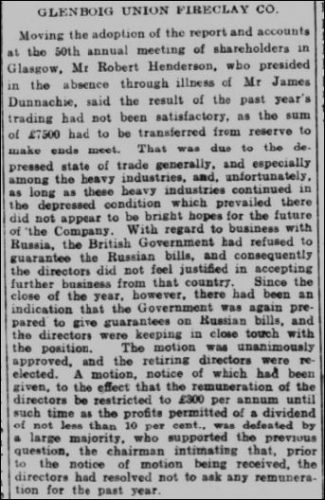
19/11/1932 – Airdrie and Coatbridge Advertiser – Austin Touring car for sale, in good condition. 22 hp, year 1924. Star Works, Glenboig.
26/05/1933 – Aberdeen Press and Journal – The Glenboig Union Fireclay Company, who have works in Lanarkshire and Dumbartonshire. have just taken up the of bricks for house-building. Beginning this week, it is expected that the company will be able to maintain an output of 16,000 bricks per day. At present the demand for housing bricks is great that schemes throughout Scotland have been held for lack of supplies.
26/05/1933 – Kirkintilloch Gazette – Glenboig Union Fire Clay Company have started making common bricks for house building and have booked large orders. Beginning this week the output is expected to be 16,000 per day at their Glenboig Works.
25/10/1933 – Coatbridge Express – Glenboig Fireclay Company’s trading loss reduced. The report of the Glenboig Union Fire-Clay Company. Ltd., for the year ended August 1933, states that the balance at the credit of profit and loss account, after transferring £4000 from the reserve fund, amounts to £241, which the directors recommend should be carried forward to next year. The ordinary capital expenditure during the year, less some small sales was £2,823. The sum of £5,308 has been expended on repairs and renewals for the year and has been paid out of revenue. The directors regret the necessity of again encroaching on the reserve fund, but the past year, as a whole, proved very disappointing in regard to the volume of trade and one of the most difficult years in the history of the company. No business was transacted with Russia during the period under review, and foreign trade, in general, was at a very low ebb. It will, however, be observed that the trading loss of £9827 in the year 1932 has been reduced to £2073 in 1933. All the economies mentioned in the last report have been carried into effect, but the company have not had the benefit thereof for a full year. Every care is being exercised by the directors in regard to the oncost expenses, but at the same time, the proper maintenance of the works has not been neglected. The directors have again agreed to forego the whole of their fees for the year covered by the accounts. The last dividend Paid was 2½ per cent for the year to August 31, 1930.
04/06/1934 – The Scotsman (06/06/1934) – Death – At Glenboig House, Glenboig on 4th June 1934 James Dunnachie, J. P. beloved husband of Naomi Napier, and late chairman and managing director of the Glenboig Union Fireclay Co Ltd. Funeral on Thursday. Cars will leave, St George’s Place Glasgow, for the Necropolis at 2 pm. Friends wishing to be present please notify Messrs Wyle & Lochhead. (No flowers, by request).
c. 1935 – Bob Millan states the footage is of the Gayne Fireclay Mine, Glenboig (aka Gain) and the brickworks are believed to be the Stein Castlelcary Works. (Note – SBH – Unfortunately the link in relation to this information has ‘disappeared’ and I cannot find it again. If anyone can point me in the right direction please get in touch).
07/11/1935 – The Scotsman – Glenboig Union Fireclay Company. Presiding at the 53rd annual general meeting of the shareholders in Glasgow yesterday, Mr Robert Henderson, chairman of directors had more pleasure in presenting the accounts this year than they had for some time back. A material in advance on past years had been made in the period under review, and the outlook was much more hopeful. Shareholders might be disappointed that though sufficient had been earned to pay some dividend, the directors had not done so. The directors had thought it advisable, in the interests of the Company, to transfer £5000 towards plant improvement, and to carry forward a sum of £2335. A revival in the home trade was experienced during the past year, and a sure index of their improvement was the progress of the iron and steel trades. Foreign business, on the other hand, had been very difficult, but on the whole, he thought he could speak more hopefully at the moment than at any time during the past three years. Mr Henderson mentioned that the Queen Mary, now being completed at Clydebank, had been fitted out with bricks made at Glenboig. The report and accounts were approved.
1936 – The Glenboig Union Fireclay Co was purchased by General Refractories Ltd, of Sheffield.
Below – 07/03/1936 – Coatbridge Leader. General Refractories offer to shareholders of the Glenboig Fireclay Company.

.
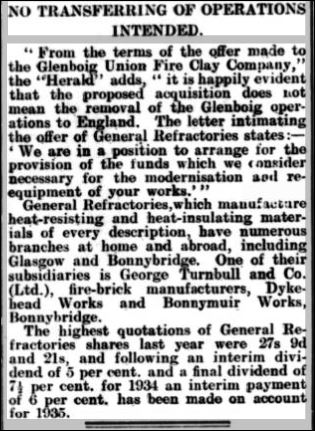
Below – August 1936 – Glenboig Advert – Queen Mary.

1937 – Listed Exhibitor, British Industries Fair. Manufacturers of Firebricks and Sanitary Pipes of every description. Specimens of the famous Glenboig clay will be shown and also shapes similar to those used in the “Queen Mary”. (Stand Nos. D.913 and D.810)
Below – 1937 – Glenboig Advert.

Below – 1937 – Glenboig Advert.
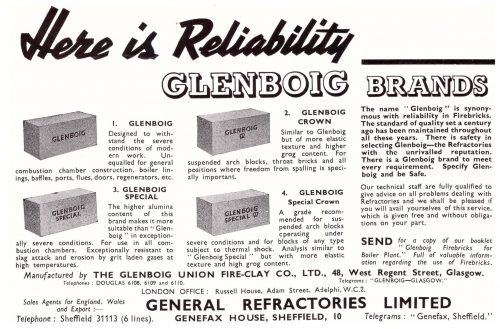
Below – 1937 – Glenboig Advert.

19/02/1937 – Western Mail – The refractories stand. Many orders expected at Birmingham The importance of refractory materials is well presented by the stand of the General Refractories Group at the British Industries Fair, Birmingham. The stand is one of the largest in the exhibition and the wide ramifications of the group are graphically represented by special maps. The design of the stand indicates the extent of the business which is expected. On top, there has been constructed a special room, in which orders can be transacted and which contains facilities for a dictaphone typist. Space is devoted to the products of various companies in the group. For instance, the Glenboig Union Fire Clay Company. Ltd. (Lanarkshire), has a large. section, in which are exhibited firebricks from several of the Scottish interests. The stand carries comprehensive displays of heat resisting and heat insulating materials. Conserving heat is one way in which the manufacturer can cut down expenses. It is certain that there will be many inquiries about the insulating firebricks on view. They save 8 per cent of waste heat and reduce fuel costs by 20 per cent. There is a striking display of the new Saxpyre product, an improved basic refractory, while there are important exhibits of moulding and silica sands.
01/04/1937 – Aberdeen Press and Journal – 37th annual general meeting of General Refractories Limited – … We are now heavily interested in the exceedingly important firebrick industries of Scotland and Stourbridge. We have acquired almost inexhaustible reserves of high-grade fireclay in both areas. It would have been easy for us to have erected extensive modern works near them, but we preferred rather to take the line of least resistance and enter the field by the purchase of existing interests, as for instance Glenboig, Turnbulls, Castlecary, and Stevens. Another advantage of this policy is that we thus acquire an existing connection and perhaps (as in the case of Glenboig) a brand held in high respect throughout the entire world. Our expansion cannot be complete until our organisation is rounded off, and by our control of a supply of refractories of every known type and for every industrial purpose, and there are still left a few departments with which we are not close enough in touch (notably glass, cement, and refractory hollow-ware), and with which we must make alliances and provision therefor in our capital structure.
15/04/1937 – Western Mail – Welsh Fair Industries Exhibition – Glenboig firebricks, manufactured from the finest range of fire clay in Scotland, are renowned for their superlative qualities. These firebricks were used throughout the boilers in the Queen Mary and many other vessels. So great is the demand for these firebricks that the local Labour Exchange has had to close down due to the fact that the Glenboig Company has absorbed all available labour.
17/07/1937 – Airdrie and Coatbridge Advertiser – An enquiry was also made into the death of David Hunter, engine fitter. Leckethilll, Gartcosh, who died on April, at the Royal Infirmary, Glasgow from a fracture of the base of the skull sustained by him as a result of an accident on the same day at the doorway of the engineering shop at Barrachnie Colliery Garrowhill occupied by the Gartocher Coal and brick Co.. Ltd. While in the employment of the Glenboig Union Fireclay Co.. Ltd., General Refractories, Glenboig, he was removing a coal cutting machine from the engineering shop by means of a chain block and tackle attached to an unfixed overhead steel girder. The girder was pulled from its position and fell to the ground striking the deceased on the head and body.
1938 – Glenboig Union Fireclay Company Limited, 48 West Regent Street, London; mine name – Cumbernauld Fireclay; Situation – Cumbernauld; Manager – A.H.MacBroom; 15 employees below ground and 4 above ground.
23/03/1938 – Coatbridge Express – Glenboig Fireclay Co dance – Officials staff and friends of the Glenboig Fireclay Company attended a dance organised by the tradesmen, in Glenboig institute on Friday night. Mr and Mrs J. Walker and Mr and Mrs H. D. Bennie were the principal guests.
1939 – Edinburgh Gazette 06/01/1939 – Faskine, Palacecraig brick and coal limited. Members voluntarily winding up. At an Extraordinary General Meeting of the above-named Company, duly convened, and held in the Offices of The Glenboig Union Fire lay Company Limited. 48 West Regent Street, Glasgow, on Tuesday the third day of January 1939, the following Resolution was duly passed as a Special Resolution, viz.:— ” That, the Company be wound up voluntarily. and that Leslie Jack Rowley. Chartered Accountant, of Genefax House, Sheffield, be and is hereby appointed Liquidator for the purposes of such winding-up. John J.M McMurdo. Chairman. 3rd January 1939.
Castlecary Fireclay Company Limited. Members voluntarily winding up. At an Extraordinary General Meeting of the above-named Company, duly convened, and held in the Offices of The Glenboig Union Fire Clay Company Limited. 48 West Regent Street. Glasgow, on Tuesday the third day of January 1939, the following resolution was duly passed as a Special Resolution, viz. :— ” That it is desirable to amalgamate the Company with The Glenboig Union Fire Clay Company Limited, and accordingly that the Company be wound up voluntarily; and that Leslie Jack Bowley, Chartered Accountant, of Genefax House, Sheffield, be and is hereby appointed Liquidator for the purposes of such winding-up. John J.M McMurdo, Chairman. 3rd January 1939.
1939 – 1940 – Glenboig Union Fire Clay Co Limited – fire brick, gas retort and sewage pipe manufacturers. Head Office Glenboig. Works Glenboig, Gartcosh, Cumbernauld, Castlecary, Dykehead, Levenseat, and Carlops. Depot head of Glebe Street, St Rollox C4. Telephone numbers 6108 -9 10 Douglas. Telegraphic address Bricks Glenboig.
25/07/1939 – Sheffield Daily Telegraph – Mr W. G. Girling has been appointed a director of General Refractories, Ltd., and of Glenboig Union Fire Clay Company. He is vice-chairman and managing director of Henry Foster and Company.
04/07/1939 – The Scotsman – Lanark County Council has been given notice by H. M. Inspector of Mines of the abandonment of the following mines: Gain Mine, Glenboig belonging to the Glenboig Union Fireclay Co., Ltd ., Glasgow … Chapelhall, belonging to the Bonnybridge Silica and Fireclay Co., Ltd., Bonnybridge.
1944 – 1967 – Map of the brickworks at Glenboig.
Below – 10/10/1944 – Foundry Trade Journal – Glenboig advert.

10/04/1945 – The Scotsman – General Refractories – The 45th general meeting, Sir Ronald W Matthews, chairman presiding … Refractories have played an essential part in the British war effort, and the Company’s well-known, brands of magnesite, chrome – magnesite and silica bricks have been used in large quantities in the furnaces in the main steel works of the country, under conditions of the greatest severity and a wartime development (with considerable postwar possibilities), namely, the “341” brick has been employed with complete success in the lining of a high percentage of the electric furnaces installed for the production of special steels. Yorkshire steel moulding sands and other moulding sands from the quarries and plants of the group in England, Scotland and Wales have been adopted as the standard in many of the bomb and tank link factories. Davison Brand products have found their uses in the chemical and cement industries and Glenboig and Foster firebricks have been used in the boilers of many warships and locomotives, in blast furnaces, and in power stations. Large shipments have been made to our Russian allies for their power station equipment. The chairman has referred to the lower turnover of the Company during 1944, which was largely due to the fact that the peak of war production appears to have passed. The reduction in the trading profit is, however, attributable more to rising costs in coal, wages and raw materials which it has not been possible to promptly absorb by increased prices. The Genefax group now consumes more than 100, 000 tons of coal per annum, and the ever-increasing cost and frequently indifferent quality of this essential commodity give rise to considerable concern. The management is very much alive to the necessity of restoring the country’s export trade, and it is interesting to record that during 1944 the sterling value of the Company’s shipments abroad was the highest in its history. The Glenboig Company’s export business was also good but many valuable orders could not be executed owing to lack of shipping space. The Company’s European contacts are also being re-established and the stage is set for a resumption of Continental business as soon as the way is clear. Assistance of a material nature has been given to the Company in the maintenance of its export trade by the Government Departments concerned …
26/04/1948 – The Scotsman – By extra effort, 100 workers at Glenboig Union Fireclay Company (Lanarkshire) have increased the output of fire-bricks by nearly 40% in 3 months.
Below – 03/12/1949 – Airdrie and Coatbridge Advertiser -An article written by Mr J McWilliam, Technical Manager, Glenboig Union Fireclay Company. “From the clay of a ‘mossy glen’ grew an industry of world renown.
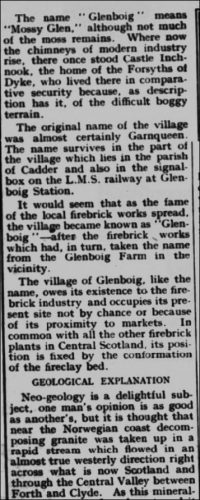
.
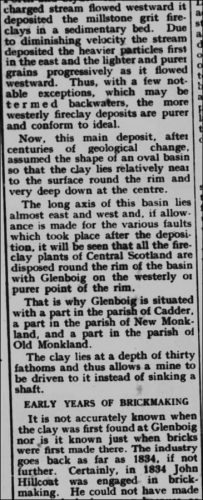
.

.

.
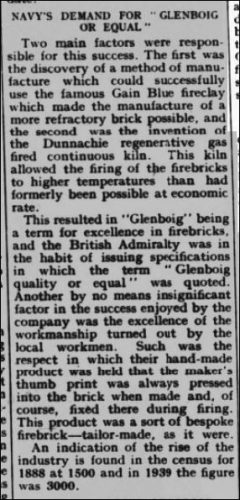
.
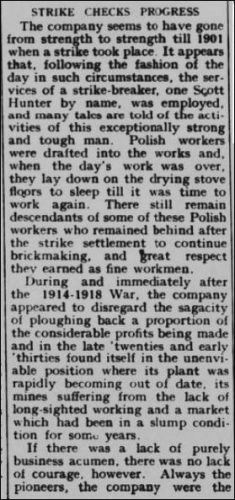
.
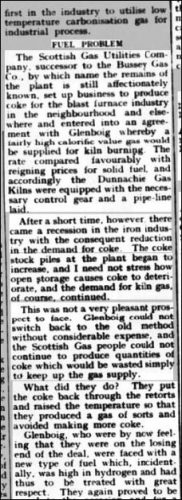
.
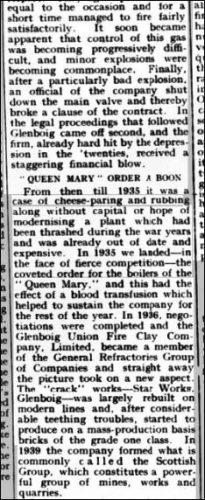
.

.
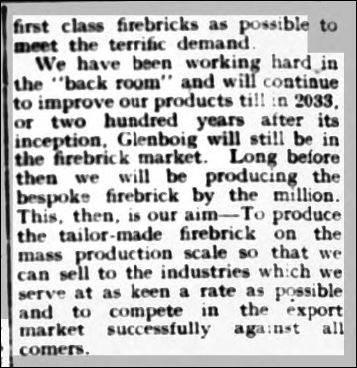
26/12/1951 – Kirkintilloch Herald – Men’s Club – The attraction at the St Andrews Men’s Club on Tuesday last was Mr A. McKendrick of Glenboig Union Fire Clay Company and of course his subject was brick making. Mr McKendrick had on view a number of fire clay ‘bricks’ in a variety of surprising shapes and in his talk he explained in a simple way, the whole process of manufacture, right from the mining to the despatch of the finished article. He also referred to a special undefined quality in the Glenboig clay which was not found anywhere else in the Country; and also drew attention to the fact that 25% of their products were sent abroad to make the name of Glenboig known almost all over the world …
11/01/1952 – Bellshill Speaker – Mr A. McKendrick, managing director of the Glenboig Union Fire Clay Company, Ltd., has been appointed chairman of the Lanarkshire District Committee of the Scottish Board for Industry in succession to the Earl of Selkirk who recently resigned taking up a Government appointment.
15/03/1953 – The British Clayworker Magazine – Glenboig Union Fireclay Co Ltd has received permission from the planning authority to work 3 seams of fireclay in an area adjoining their existing workings. The development promises enough fireclay to maintain production for some 50 years. It is possible that open cast working may be undertaken in addition to the mining activities and if this were so a further application would be made.
c. 1954 – Culturenlmuseums – The Star Works, Glenboig.

24/11/1954 – Kirkintilloch Herald – Clerkess senior required immediately; previous invoicing experience an advantage, must be accurate with figures. Apply stating full details of age, experience, and salary required to Personnel Office, Glenboig Union Fire Clay Co Ltd, Glenboig, Lanarkshire.
22/04/1955 – Truth – Genefex expansion plans. The modest fall in trading profits of General Refractories, known as the Genefex group, which manufactures heat resisting and heat insulating materials, was not altogether unexpected in view of the statement by the chairman, Sir Ronald Matthews, a year ago, that there was a reduction in demand for the firebrick side of the business. This chiefly affected the subsidiary, the Glenboig Union Fire Clay, but there is consolation in the fact that an improvement has been in evidence since the beginning of the current year, and prospects are now much brighter. With the exception of firebricks, the company’s works were employed to capacity last year and at the present time, there is a good demand for most of its products, which has encouraged the company to proceed with its plan of expansion. In the past year capital expenditure on plant modernisation amounted to £364,000 and a further £150,000 is down for spending in this connection to enable the company to expand into profitable fields and increase its competitive efficiency. An interesting development is the resumption of business with Argentina as a result of some relaxation of exchange restrictions. These restrictions have kept the company out of this market for some years. The dividend on the Ordinary shares was maintained at 17½ per cent last year and was well covered by earnings.
13/07/1957 – Airdrie and Coatbridge Advertiser – Did Not Have Guard on Machine The Glenboig Union Fireclay Company, Ltd., were fined £5 and ordered to pay £1 0s 6d. expenses at Airdrie Sheriff Court yesterday, when they admitted failing to have a guard on one of their brickmaking machines at the Star Works, Glenboig. between 2nd and 23rd April. A factory inspector told Sheriff Thomas Young that the (company employed about 180 persons in the works. The Inspector stated that a guard should have been provided for the belts and pulleys on one of the machines, but it appeared that it had been taken off to carry out repair work on the machine, and had been left “lying in a corner” and had not been put back on the machine. On Tuesday. 23rd April, the inspector continued, this machine was in use and it was found that there was no guard on the belts and pulleys, and on that day at least one man had been working in close proximity to them. On enquiries being made, it was discovered that a sheet metal guard had been provided for the machine. The guard was quite suitable for the purpose of covering the belts and pulleys. In conclusion, the inspector stated that the company had failed in their duty to ensure that the guard was put back after the repairs had been effected. An agent, appearing on behalf of the Glenboig firm tendered a plea of guilty. He pointed out that the guard had been taken off to carry out some minor repairs on the conveyor belt of the machine and this had been done a week or two before the offence was discovered. The agent said that he had been told that the repairs to the machine had not proved completely satisfactory and, in fact, it was the intention of the company to do away with the machine which could obviate the necessity of a conveyor belt being used at all. The responsibility of the guard being replaced lay with the company, he continued, although, in practice, it was left with the foreman on the machine platform to see that this was carried out. “My clients.” said the agent, both on this occasion, and on many occasions in the past, have made it very clear and obvious to all their foremen that if a guard was removed from a machine for any reason, it must be replaced. My clients have many large establishments up and down the Scottish industrial scene and this is the first occasion that any complaint has been brought against them under this Act. They have thousands of machines in operation in their factories and make strenuous efforts to ensure that they are guarded. The complaint is the result of an isolated occurrence. Sheriff Young fined the firm £5 and ordered them to pay the costs of the case.
1958 – The “Old Works” in Glenboig closed (and were demolished by 1965).
Below – 1959 – Glenboig Union Fireclay Company, Ltd.
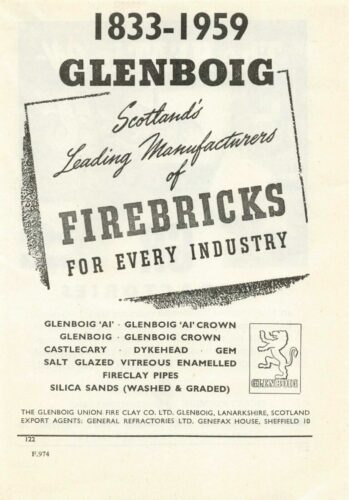
Below – c. 1960 The Glenboig Starworks.
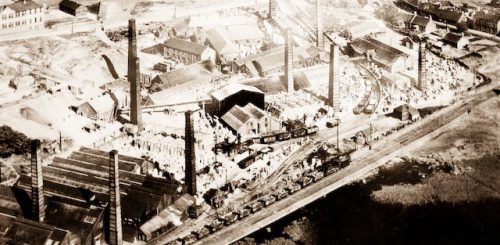
Below – 01/1960 – Refractories Journal – An advert for Glenboig bricks including the stamps Numax, Sillmax 1, Glenboig SD and Glenboig 50.

1961 – 1962 – A directory of British clay products and manufacturers – Glenboig Union Fireclay Co Ltd (a member of the General Refractoried Ltd Group), Glenboig near Glasgow. Fire bricks. Tade name – ‘Glenboig’.
Below – 02/1962 – Refractories Journal – An advert for Glenboig bricks including the stamps ‘Glenboig A 1’, ‘Glenboig’, ‘GEM’ and ‘Castlecary. In 1936 General Refractories took over the Castlecary Fireclay Co Limited and the company became part of the Glenboig Union Fireclay Company. It appears that the GUFC continued the CFCL brands that were ‘GEM’ and ‘Castlecary’.
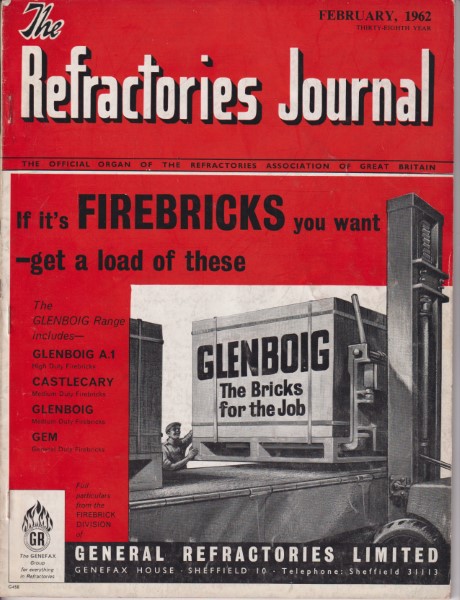
13/11/1962 – The Scotsman – Sheriff dismisses £2000 claim. Sheriff Thomas Young, of Airdrie, in his interlocutor issued yesterday, dismissed a widow’s £2000 claim against a Glenboig Company after the widow’s agent had put up no opposition to the defender’s submissions. Mrs Ellen Neilson or Hinds, 27 Slakiewood Avenue, Gartcosh, had brought the claim against the Glenboig Union Fireclay Co., Ltd., Star Works, Glenboig, in respect of her husband’s death on November 25, 1958. She maintained that he developed pneumoconiosis through his employment with the firm.
01/05/1964 – West Lothian Courier – Appeal – Restrictions imposed by West Lothian County Council’s planning committee on a development proposed the Glenboig Union Fireclay Co to win and work minerals at Fauldhouse are to be the subject of an appeal to the Secretary of State for Scotland, Mr Michael Noble. The company plan to extend existing workings to the Crofthead and Croftfoot Districts. A county official said, “The conditions concern the amount of fireclay to be taken out. The reason for the restrictions is to safeguard the surface land for possible future development”.
Below – 09/1964 – Refractories Journal – The British Ceramic Society visit the Glenboig Union Fire Clay Company Limited.

.
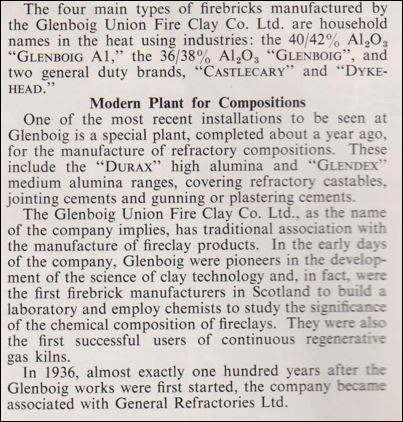
.
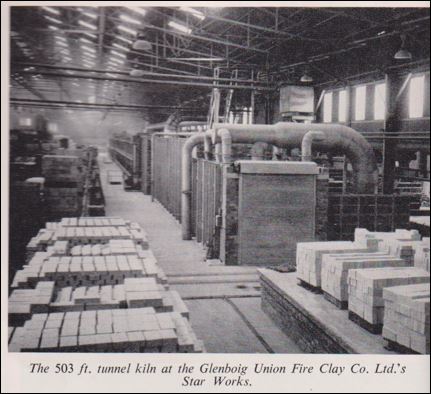
1967 – General Refractories became G. R. Stein Refractories Ltd.
1974 – The “Star Works” closed sometime after 1974.
06/09/1978 – Glasgow Herald – Article on Richard Smith who used to work for Thomson Mclean & Co.
A further source of information – The manufacture began some 4-5 miles west of Glenboig in Garnkirk at Cardowan Fireclay in 1833/4, near the village of Gartcosh. The records show that in 1836 a John Hillcoat was engaged in firebrick melting at Garnqueen, but in spite of the fact that the fireclay in the Gartcosh, Garnkirk and Cardowan areas was inferior to that at Garnqueen, John Hillcoat didn’t enjoy great success because in 1860, some 26 years later, the population of the village of Garnqueen only numbered 120. In this period, it would appear that the village acquired the name ‘Glenboig’, and Garnqueen was incorporated into Glenboig village. [By 1891 the population was 1,500, and in 1981 it was 2,000].
By 1843 Glenboig Fire Brick and Tile Works was owned by Mr John Thomson, and the original works (the Old Works) was built beside the Monkland-Kirkintilloch railway. Around 1860, Messrs Thomson, McLean & Company acquired the right to work the fireclay in the Glenboig area, and firebricks were beginning to be produced on a much larger scale. Messrs Hurll, Young & Company were operating at Heathfield and Cardowan works, using the same seam of clay, although of a different quality, and they took over from Thomson McLean & Co in 1865, forming the Glenboig Fireclay Company with Mr James Dunnachie as Managing Partner.
The partnership dissolved in 1872 when John Hurll acquired sole ownership of the Glenboig Fireclay Co., (the Old Works) and for a period of around eight years, they expanded to become one of the best-known firebrick manufacturers in Britain with a market in many countries around the world.
After James Dunnachie left the Glenboig Fireclay Company he set up in business for himself, forming James Dunnachie & Company and he built the Star Works, literally across the road from Hurlls. Dunnachie’s bricks, at that time, were stamped ‘J.D.’ and the title ‘Star Works, Glenboig’ or ‘Glenboig’ with a star below the word.
The quality of Star and Glenboig firebricks became well established throughout the world. Between 1875 and 1882 they won major awards for refractory products in exhibitions as far apart as Santiago, Melbourne, Paris, London and Sydney. Even before amalgamation, Glenboig bricks had won awards at exhibitions around the world. James Dunnachie and John Hurll had made Glenboig famous. For ten years Dunnachie and Hurll were in an intense competition until August 1882 when they amalgamated the Old Works and the Star Works and founded The Glenboig Union Fireclay Company with their head office at 4 West Regent Street, Glasgow. (At that time the company also operated Cumbernauld Fireclay Co; Faskine and Palacerigg Bricks and Coal; G. Turnbull & Co).
Between 1870 and 1881 James Dunnachie had taken out three patents on inventions, the most important one which brought him fame and fortune was the Continuous Regenerative Gas Kiln which was designed to burn gas in a more economic, even way with the benefit of a reduction in atmospheric pollution.
Dunnachie had great business acumen and is credited with the development of the Glenboig Union Fireclay Company into a major industry providing the world with firebricks of unequalled excellence through his inventions and organising ability.
The company specialised in the production of furnace lining bricks and pipe-work for the iron and steel industry which was flourishing in the nearby industrial towns. They also made cattle troughs, cisterns, horse mangers, washing tubs, sheep-dipping troughs, pig troughs, pickling dishes, garden edging, fountains, balusters and much more.
In 1889 the company reorganised the method of supplying the clay to the moulders which allowed one man to do work previously done by eight and a simplification to the method of breaking up the rock-like clay so that the amount and cost of labour was reduced to a minimum. Hand moulders were said to have made in excess of two thousand bricks each per day, men being preferred to machines which required constant repair due to the very hard particles in the Glenboig clay. Glenboig was firmly established as the leading centre of refractory products in the world. Even today Glenboig bricks turn up all over the world.
End of an era – Death of James Dunnachie. It was the end of an era for Glenboig. James Dunnachie died and left a movable estate of £19,297, less than he had been paid for his patents in 1822. He had spent 60 years of his life in Glenboig and had been responsible for making it world-famous. He wrote his memoirs in 1903 covering the period of his life from 1835 to 1903 and the typescript is held in the University of Glasgow Special Collections, but there is no official memorial to his services to the area, not even a street name. The company was unable to cope with the depression of 1929, and trading losses were made in 1931 to 1935, and in April 1936 the Glenboig Union Fireclay Company Limited was purchased by General Refractories Limited of Sheffield. There was a revival when Glenboig bricks were used in the building of the Queen Mary, and again at the outbreak of the Second World War, but the Old Works were closed in 1958 and demolished before 1965.
In 1967 General Refractories amalgamated with G.R. Stein Refractories Ltd. The Star Works was closed by 1966., and the chimney demolished by 1988. John Hurll had retired in 1882, but his two sons Peter and Mark, returned to Glenboig in 1888 starting Garnqueen and Gartliston works. Little information is available about the company, but it employed 300 men and women above ground at Gartliston works and a further 100 men below ground. Production was about 3,000 tons of firebricks a month. The company went into liquidation in 1980.
The Glenboig Union Fireclay Company Limited, Glenboig near Coatbridge, and 4, West Regent Street.— This well-known and representative concern (which is by far the largest of the kind in Europe and whose extensive operations illustrate a very important and typical branch of Scottish industry, has been known in Glasgow commercial and industrial circles under its present style as the Glenboig Union Fireclay Company, Limited, since 1882. The undertakings of the company and the industry it controls are of much earlier origin, however, dating their history back as far as 1836. In 1860 the concern was reconstructed and came under the management of Mr James Dunnachie. The firm at that time was Thomson, MacLean & Co. In the year 1865, the Glenboig Fireclay Company was formed, Mr Dunnachie being the managing partner. In 1872 this firm was dissolved, and in the following year Mr Dunnachie established the Star Glenboig Works, when, after competing for ten years with the old works, the two concerns amalgamated and were turned into a limited company under the present designation, the Glenboig Union Fireclay Company, Limited, with a capital of £150,000.
The company now control two extensive working establishments at Glenboig, the Old Works and the Star Works respectively, and have another large place at Cumbernauld, each of these works being the headquarters of some branches or department of the company’s operations, which embraces the mining for fireclay and the subsequent production of bricks, tiles, and all descriptions of superior fireclay goods.
Glenboig has long been known favourably for its possession of a most valuable seam of fireclay. The analysis of this clay by Edward Riley, F.C.S., in 1875, manifested its possession of the most valuable properties of fireclay in a high degree, and showed it to be “very free from any bases, such as oxide of iron, lime, &c., that have a tendency to make the clay soften with heat”. Many other favourable reports and analyses on the same fireclay have been forthcoming, and they tend to indicate that the Glenboig Union Company is now possessed of, and actively working, one of the most valuable beds of fireclay in the United Kingdom. The works are of great extent and admirable equipment, and upwards of six hundred men are constantly in employment.
The Glasgow offices constitute the commercial headquarters of the concern. At the head of Glebe Street, St. Rollox, there is also a large depot at which stocks of great magnitude are held.
The company’s specialities comprise the various bricks, blocks, &c., required for Siemens’ patent regenerative gas furnace, forge, and rolling mill furnaces, copper-calcining and refining furnaces, glass and chemical furnaces, puddling and blast furnaces, &c., and in addition to the above there are produced special bricks for Ford & Moncur’s stove, Cowper’s stove, Whitwell’s stove, Bauer’s coke oven, Klonnes’ gas furnaces, Siemens’ producer, and the Wilson and the Sutherland producers. The company are likewise sole makers for Scotland of basic bricks for the Thomas-Gilchrist dephosphorising process, and they also manufacture the special bricks for the Siemens’ process, Gorman tubes, Bessemer tuyeres. Silica bricks, blue bricks for acid chambers, gas retorts, and all descriptions of settings; enamelled bricks, glazed sewage pipes, enamelled and salt-glazed cattle troughs and sanitary appliances, and the Glenboig ironstone paving tiles for railway stations, all hold prominent places in the list of special features developed by this great and progressive industry.
A very large and important trade is controlled, extending to all parts of the world, and the home connection is of the most influential order throughout the three kingdoms. The Glenboig works are in many respects unique, and have the advantage of improved methods of manufacture, several of them patented. The most important of these is Mr Dunnachie’s patent regenerative gas kiln, which saves from fifty to seventy-five per cent, in the cost of burning, abolishes smoke, and improves the quality of the manufacture.
The company have carried off many distinguished medallic honours, and of these well-earned successes the following are a representative selection: Paris, 1878, three silver medals; Santiago, Chile, 1875, a prize medal; London, 1884, first-class award; London, 1885, a gold medal; Calcutta, 1884, highest award for firebricks; Amsterdam, 1883, gold medal; Glasgow, 1880, two medals of the Philosophical Society; Melbourne, 1880, three medals; Inventions Exhibition, 1885, a silver medal; Glasgow Mining Exhibition, 1885, silver medal; Antwerp, 1885, a gold and a bronze medal; and a medal at the Smoke Abatement Exhibition, held in London in 1882; at the Edinburgh and Liverpool Exhibitions of 1886, silver medals were awarded.
****************************************
The chairman and managing director of the Glenboig Union Fireclay Company, Limited, was born at Pollokshaws in 1835. His paternal ancestors were Jacobite Highlanders, but on the mother’s side, he is a Lowland Scot. It was in 1860 that he went to Glenboig. The clayfield had been discovered and first exploited in 1846, at the time of the great expansion of the iron industry in Lanarkshire. The brick made from it was used for lining the iron furnaces which sprang up everywhere in the region. But Mr Dunnachie vastly improved the manufacture, and on the dissolution of the firm of which he was managing partner in 1872, he took a lease of the unlet portion of the Glenboig Clayfield, consisting of six-sevenths of the whole, and started the Star Works. Here he gave special attention to the needs of the new steel industry, which required a brick that would not split off inside the furnace and fill the metal with impurities. In a paper read before the British Association, he described this as “a brick high in silica, yet containing a fair proportion of alumina, and comparatively free from alkalis and other impurities.” Very soon, owing to his energy, the Star Works became the largest producers of fireclay manufactures in the kingdom. In 1882 the Star Works and the Glenboig Company’s old works were amalgamated, with a capital of £150,000, and since that date, other works have been acquired at Cumbernauld and Gartcosh.
Among Mr Dunnachie’s many improvements in the process of manufacture is the continuous regenerative gas kiln, which has not only abolished smoke, and reduced cost by more than one half, but improved the quality of the brick. But this is only one of his numerous patents. Each of the works is devoted to a particular branch of the manufacture, but every kind of fireclay work is produced by the company. About one thousand “hands” are employed, and the effect of the industry on the prosperity of the region may be judged from the fact that, while in 1860 the village of Glenboig contained only some 120 souls, it has now a population of nearly 3,000.
Mr Dunnachie is assisted in the management by his son, Mr Archibald H. Dunnachie, who is general manager of the works, and who has had special scientific training. Apart from the business, Mr Dunnachie is a J.P. for Lanarkshire and a liberal patron of the fine arts. He has travelled much abroad and possesses trophies and curios gathered in many lands, savage and civilised.
*****************************************
Company History – The Glenboig Union Fireclay Co. Ltd was founded by James Dunnachie & partners by the amalgamation of the “Old Works” and the “Star Works” in Glenboig. The company specialised in the production of refractory ceramic goods (e.g. furnace lining bricks and pipework) for the iron and steel industry which was flourishing in numerous nearby large industrial towns. By expansion and/or take-overs the company went on to operate several other works, viz.: Cumbernauld Fireclay Works & Mine (c.1882); Gartcosh Works (1890); Castlecary Fireclay Co. Ltd (1919 ?); Faskine & Palacerigg Bricks & Coal Ltd (1919 ?); George Turnbull & Co. Ltd – Bonnymuir and Dykehead Works (1919 ?). The Glenboig Union Fireclay Co. Ltd was purchased by General Refractories Ltd of Sheffield in 1936 which in turn became G.R. Stein Refractories Ltd in 1967.
The “Old Works” in Glenboig closed in 1958 and were demolished by 1965.
The “Star Works” closed sometime after 1967. The company was subsequently purchased by General Refractories which later became part of GR Stein, and its activities wound down. It was listed as dormant in 2002.
James Dunnachie – Fire-clay brick manufacture began in the Scottish Central belt at Glenboig in the 1830s but its development to a major industry providing the world with firebricks of unequalled excellence must in large part be credited to the invention and organising ability of James Dunnachie at Glenboig, from 1860.
Born at Pollockshaws, son of a Renfrewshire bleacher, James Dunnachie came to Glenboig at 28 years old and soon became manager of the existing small fire-clay company.
In 1865 he formed the Glenboig Fire-Clay Company with John Hurll and John Young, themselves pioneer firebrick manufacturers, and when the partnership folded in 1872, Dunnachie built the Star-Works immediately adjacent to the old works and in competition with them.
His bricks at this time bore the legend J D and the title “Star Works, Glenboig” or “Glenboig” with a star imprinted below the word. In the rescued brick below you can see the remnants of the Star below the letters NB.
In 1882 the two companies decided to amalgamate as the Glenboig Union Fireclay Company Ltd with Dunnachie as Managing Director.
Glenboig Union Fireclay Co – of Glenboig, near Glasgow, Scotland. Telephone: Glenboig 66. Telegraphic Address: “Glenboig, Scotland”
Fire-clay brick manufacture began in the Scottish Central belt at Glenboig in the 1830s but its development to a major industry providing the world with firebricks of unequalled excellence must in large part be credited to the invention and organising ability of James Dunnachie at Glenboig, from 1860.
The Glenboig Union Fireclay Co was founded by James Dunnachie and partners by the amalgamation of the “Old Works” and the “Star Works” in Glenboig. The company specialised in the production of refractory ceramic goods (e.g. furnace lining bricks and pipework) for the iron and steel industry which was flourishing in the nearby industrial towns.
Born at Pollockshaws, son of a Renfrewshire bleacher, James Dunnachie came to Glenboig at the age of 28, and soon became Manager of the existing small fire-clay company.
It had already been proved that Glenboig bricks were superior to all others in Britain including the highly regarded Stourbridge and Newcastle bricks. James Dunnachie was to build on this reputation such that regular orders were received from as far as Russia, Canada, India, Australia and South America as well as over Europe. Medals and awards for Glenboig products were won all over the world.
James Dunnachie 1835-1921
James Dunnachie Jun – Died – 04/06/1934 at Glenboig House, Glenboig. Beloved husband of Naomi Napier and ex-chairman and managing director of the Glenboig Union Fire clay Co)
*****************************
Below – 3 metal gully grates or grills seen in Glenboig and marked Glenboig and Glenboig Cumbernauld Coy.
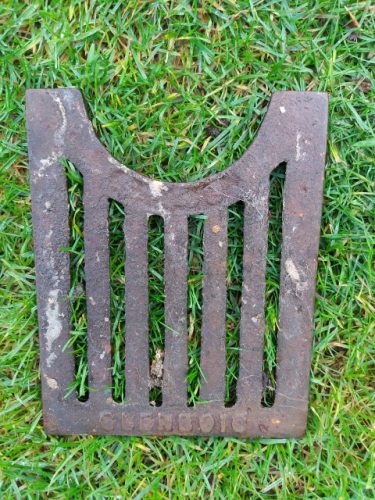
.

.

Below – Brass stamp photographed at Glenboig – Glenboig.
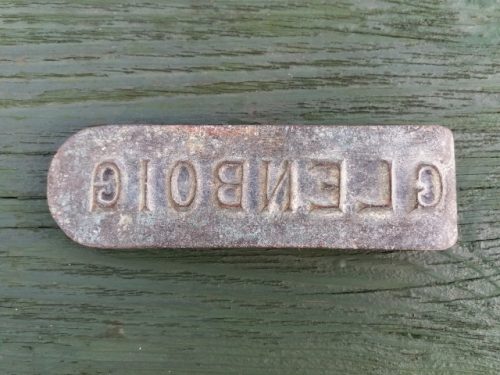
Below – A small salt glazed trough seen in a garden at Glenboig. It is not stamped but it is believed to have been made at the Glenboig Union Fireclay Works.

.

.
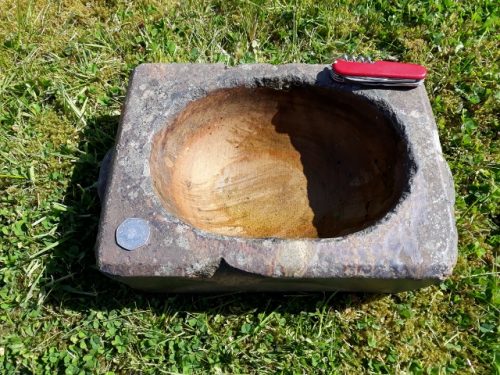
.

Below – 2 unmarked narrow slips found on the Glenboig Union Fireclay site. One is 1 1/2″ deep and the other 1″. Undoubtedly this is a Glenboig product.

.

Below – The Scottish Industrial Archaeology Survey published a report in 1985 entitled ” A survey of Scottish brickmarks. During the compilation of this report in which the survey officers visited working and derelict brickworks sites, many items of interest were donated or found. Many of these items were thereafter donated to the National Museum Scotland. The item below is one of these items.
A fireclay wall plaque approx measuring 16″ x 10″ x 1 1/2″. It was recovered from James Dunnachies house. Notes on the recovery date it to c. 1880. The notes also say that Mr Dunnachie travelled all over the world with regards to his fireclay business. One returning from one such trip (location not given) he gave his fireclay moulders a drawing of something he had seen while he was abroad and asked them to replicate it. This was the result. No explanation is given as to what it represents.

Below – Information – British Geological Survey – Indian Kyanite. Indian kyanite supplied to the Glenboig Union Fireclay Company Limited 18.2.37
Indian kyanite supplied to the Glenboig Union Fireclay Company Limited 18.2.37
Kyanite is a mineral composed of aluminium silicate. It belongs to the triclinic crystal system and generally forms elongated tabular crystals and is usually blue in colour, often in zones with darker blue in the centre of the crystal.
It is found in pelitic rocks that have undergone high-pressure metamorphism and are often associated with garnet, staurolite and mica.
Its commercial uses were as a raw material for high-temperature porcelain, perfect electrical insulators and acid-resistant products. The Glenboig Union Fireclay Company Limited had offices in Glasgow and works at Glenboig where it processed material from its Gain Mine and Gartcosh Pit for refractories.
Below – Information – British Geological Survey. A specimen of the Glenboig Main Fireclay from Glenboig, Lanarkshire
Glenboig Main Fireclay from the Glenboig Union Fireclay Company. The specimen was sent to Dr Simpson of the Geological Survey of Great Britain from Mr. McBroon. Fireclays are poorly-bedded mudstones consisting essentially of kaolinite; most are seat clays below coals, but many of the most sought after aluminous beds are not associated with coal.
Fireclay was once worked extensively in the Central Coalfield, especially underground. Most fireclay now is worked opencast. Fireclay production in Scotland has fallen dramatically and reached an all-time low in the 1980s as a result of the decline of the Scottish iron and steel industry